Manage Inventory - Study Material and Solved Assignments | Desklib
VerifiedAdded on 2023/06/18
|37
|8219
|353
AI Summary
This study material on Manage Inventory covers topics such as forecasting methods, purchase orders, stock ordering responsibilities, costing a restaurant menu, and more. It includes information on sourcing suppliers and product information, purchase specifications, and individual stock ordering responsibilities. The content also lists alcoholic and non-alcoholic beverages, types of foods, and other goods that may need to be purchased by a hospitality business.
Contribute Materials
Your contribution can guide someone’s learning journey. Share your
documents today.
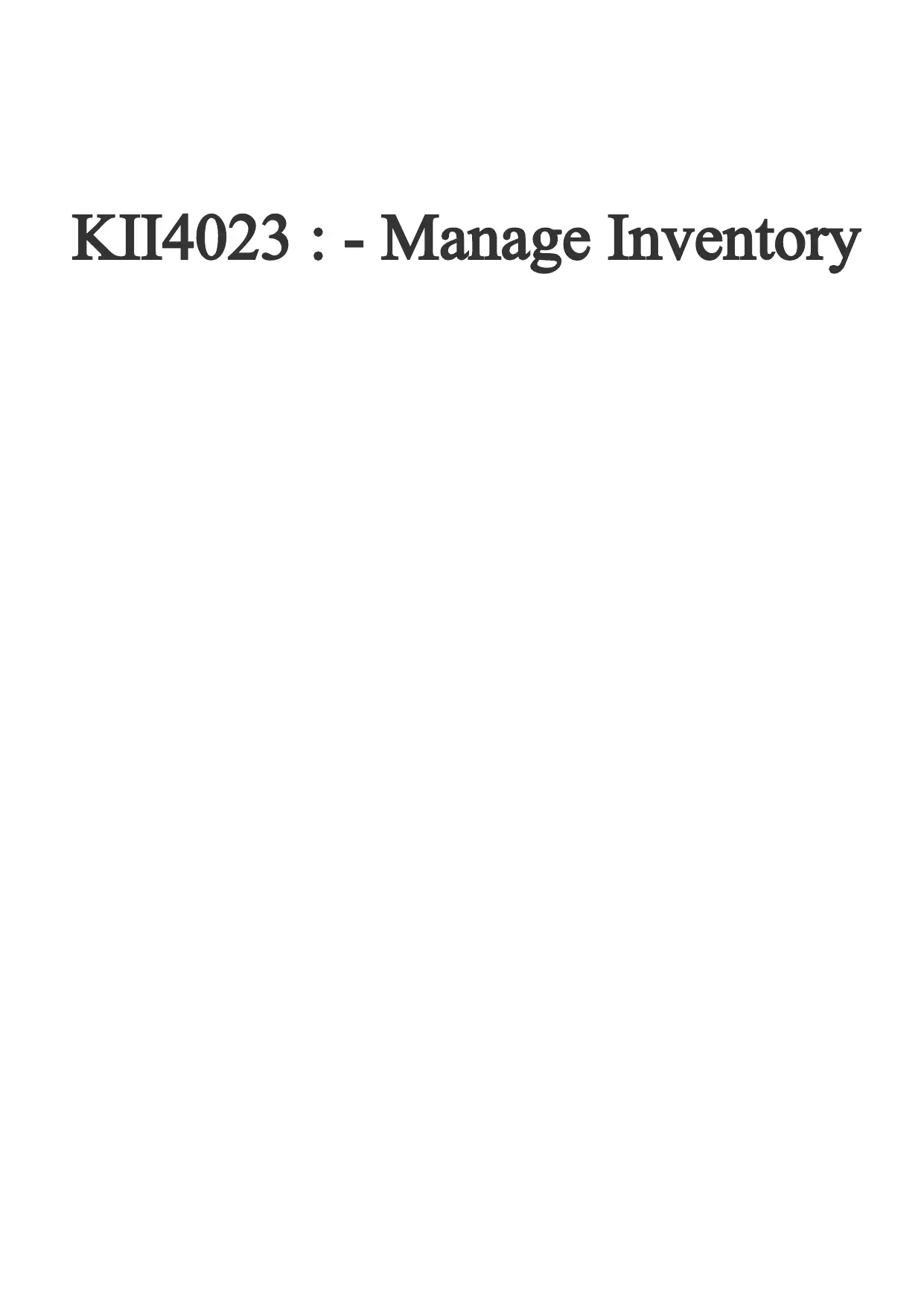
KII4023 : - Manage Inventory
Secure Best Marks with AI Grader
Need help grading? Try our AI Grader for instant feedback on your assignments.

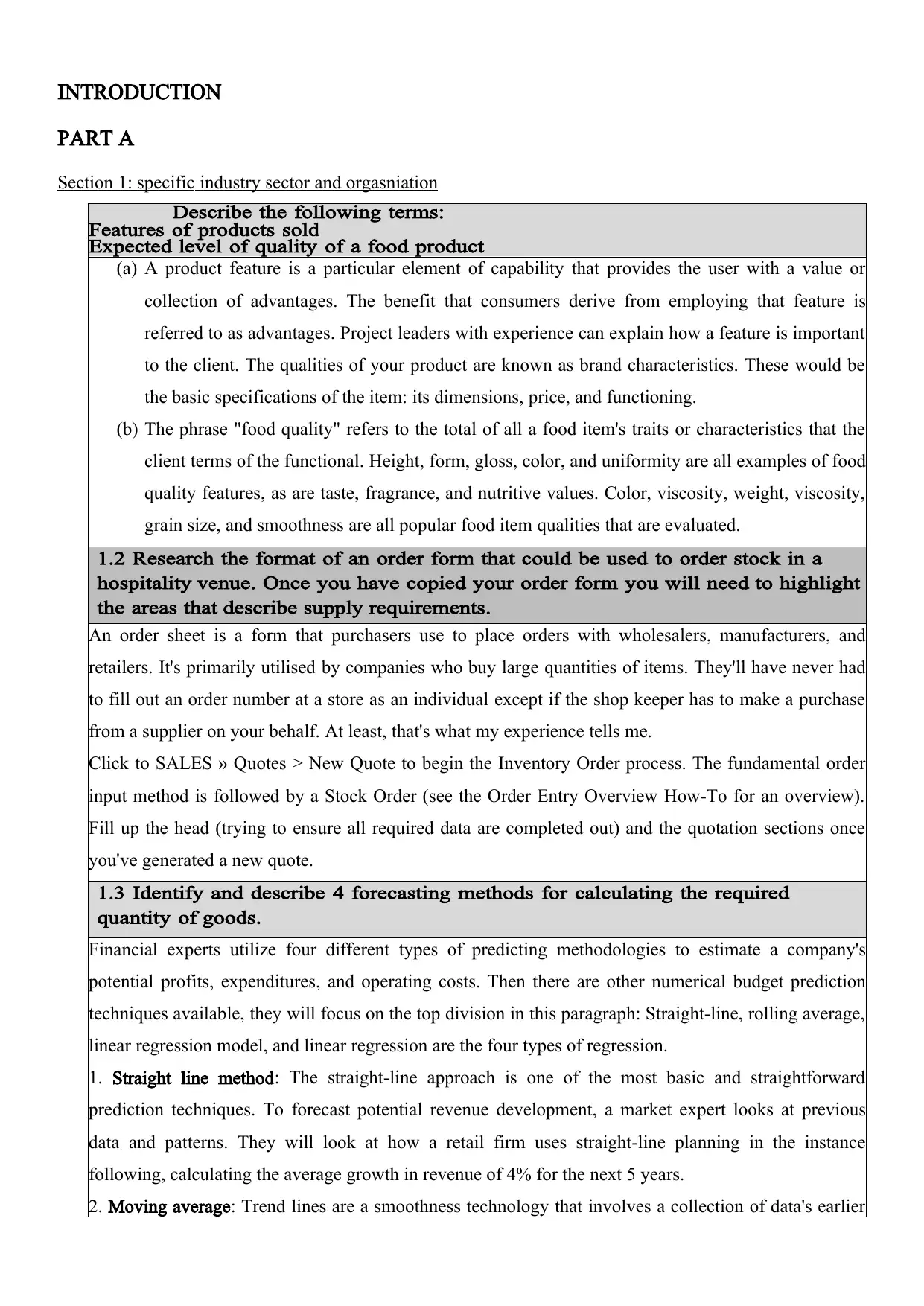
INTRODUCTION
PART A
Section 1: specific industry sector and orgasniation
Describe the following terms:
Features of products sold
Expected level of quality of a food product
(a) A product feature is a particular element of capability that provides the user with a value or
collection of advantages. The benefit that consumers derive from employing that feature is
referred to as advantages. Project leaders with experience can explain how a feature is important
to the client. The qualities of your product are known as brand characteristics. These would be
the basic specifications of the item: its dimensions, price, and functioning.
(b) The phrase "food quality" refers to the total of all a food item's traits or characteristics that the
client terms of the functional. Height, form, gloss, color, and uniformity are all examples of food
quality features, as are taste, fragrance, and nutritive values. Color, viscosity, weight, viscosity,
grain size, and smoothness are all popular food item qualities that are evaluated.
1.2 Research the format of an order form that could be used to order stock in a
hospitality venue. Once you have copied your order form you will need to highlight
the areas that describe supply requirements.
An order sheet is a form that purchasers use to place orders with wholesalers, manufacturers, and
retailers. It's primarily utilised by companies who buy large quantities of items. They'll have never had
to fill out an order number at a store as an individual except if the shop keeper has to make a purchase
from a supplier on your behalf. At least, that's what my experience tells me.
Click to SALES » Quotes > New Quote to begin the Inventory Order process. The fundamental order
input method is followed by a Stock Order (see the Order Entry Overview How-To for an overview).
Fill up the head (trying to ensure all required data are completed out) and the quotation sections once
you've generated a new quote.
1.3 Identify and describe 4 forecasting methods for calculating the required
quantity of goods.
Financial experts utilize four different types of predicting methodologies to estimate a company's
potential profits, expenditures, and operating costs. Then there are other numerical budget prediction
techniques available, they will focus on the top division in this paragraph: Straight-line, rolling average,
linear regression model, and linear regression are the four types of regression.
1. Straight line method: The straight-line approach is one of the most basic and straightforward
prediction techniques. To forecast potential revenue development, a market expert looks at previous
data and patterns. They will look at how a retail firm uses straight-line planning in the instance
following, calculating the average growth in revenue of 4% for the next 5 years.
2. Moving average: Trend lines are a smoothness technology that involves a collection of data's earlier
PART A
Section 1: specific industry sector and orgasniation
Describe the following terms:
Features of products sold
Expected level of quality of a food product
(a) A product feature is a particular element of capability that provides the user with a value or
collection of advantages. The benefit that consumers derive from employing that feature is
referred to as advantages. Project leaders with experience can explain how a feature is important
to the client. The qualities of your product are known as brand characteristics. These would be
the basic specifications of the item: its dimensions, price, and functioning.
(b) The phrase "food quality" refers to the total of all a food item's traits or characteristics that the
client terms of the functional. Height, form, gloss, color, and uniformity are all examples of food
quality features, as are taste, fragrance, and nutritive values. Color, viscosity, weight, viscosity,
grain size, and smoothness are all popular food item qualities that are evaluated.
1.2 Research the format of an order form that could be used to order stock in a
hospitality venue. Once you have copied your order form you will need to highlight
the areas that describe supply requirements.
An order sheet is a form that purchasers use to place orders with wholesalers, manufacturers, and
retailers. It's primarily utilised by companies who buy large quantities of items. They'll have never had
to fill out an order number at a store as an individual except if the shop keeper has to make a purchase
from a supplier on your behalf. At least, that's what my experience tells me.
Click to SALES » Quotes > New Quote to begin the Inventory Order process. The fundamental order
input method is followed by a Stock Order (see the Order Entry Overview How-To for an overview).
Fill up the head (trying to ensure all required data are completed out) and the quotation sections once
you've generated a new quote.
1.3 Identify and describe 4 forecasting methods for calculating the required
quantity of goods.
Financial experts utilize four different types of predicting methodologies to estimate a company's
potential profits, expenditures, and operating costs. Then there are other numerical budget prediction
techniques available, they will focus on the top division in this paragraph: Straight-line, rolling average,
linear regression model, and linear regression are the four types of regression.
1. Straight line method: The straight-line approach is one of the most basic and straightforward
prediction techniques. To forecast potential revenue development, a market expert looks at previous
data and patterns. They will look at how a retail firm uses straight-line planning in the instance
following, calculating the average growth in revenue of 4% for the next 5 years.
2. Moving average: Trend lines are a smoothness technology that involves a collection of data's earlier
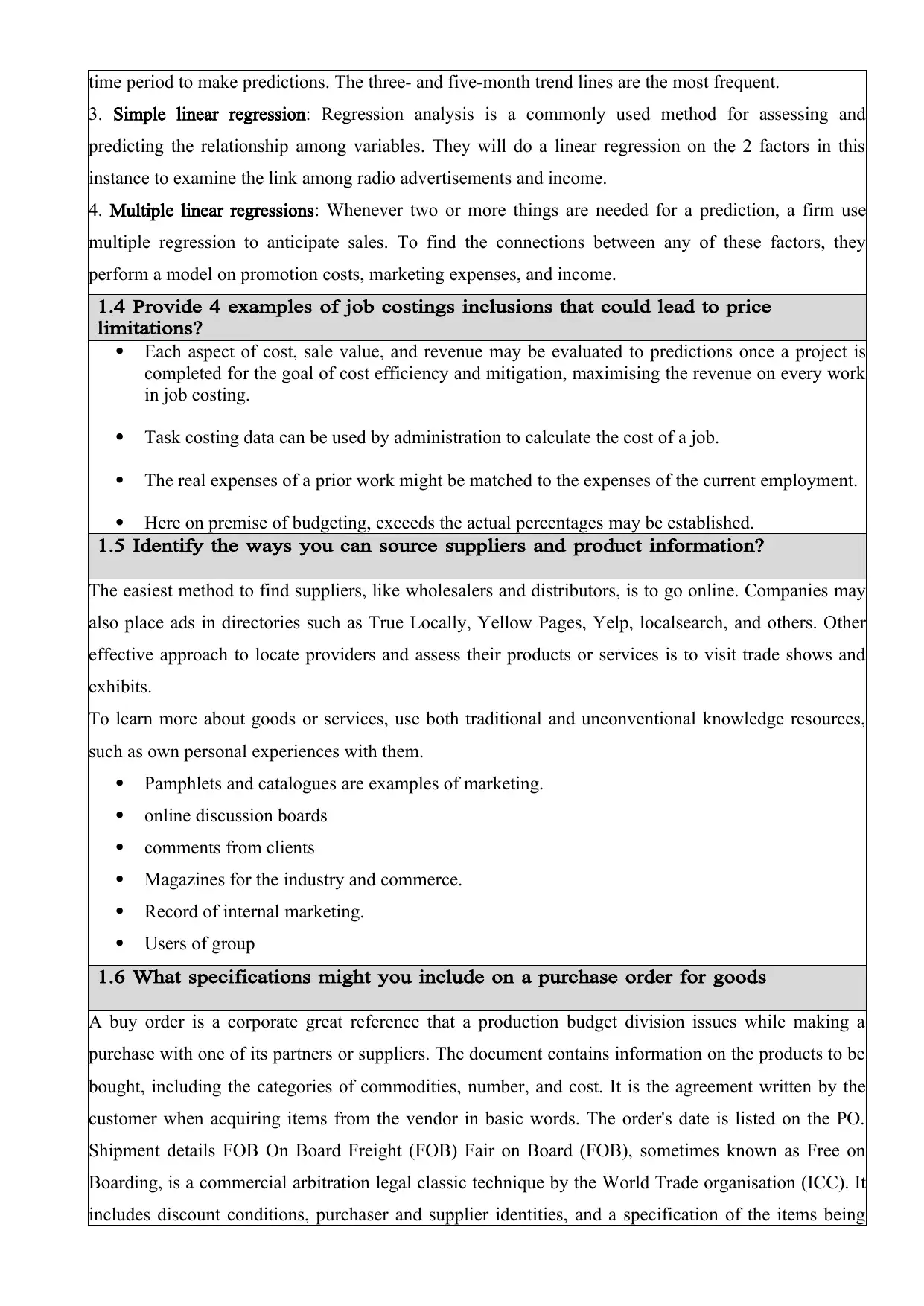
time period to make predictions. The three- and five-month trend lines are the most frequent.
3. Simple linear regression: Regression analysis is a commonly used method for assessing and
predicting the relationship among variables. They will do a linear regression on the 2 factors in this
instance to examine the link among radio advertisements and income.
4. Multiple linear regressions: Whenever two or more things are needed for a prediction, a firm use
multiple regression to anticipate sales. To find the connections between any of these factors, they
perform a model on promotion costs, marketing expenses, and income.
1.4 Provide 4 examples of job costings inclusions that could lead to price
limitations?
Each aspect of cost, sale value, and revenue may be evaluated to predictions once a project is
completed for the goal of cost efficiency and mitigation, maximising the revenue on every work
in job costing.
Task costing data can be used by administration to calculate the cost of a job.
The real expenses of a prior work might be matched to the expenses of the current employment.
Here on premise of budgeting, exceeds the actual percentages may be established.
1.5 Identify the ways you can source suppliers and product information?
The easiest method to find suppliers, like wholesalers and distributors, is to go online. Companies may
also place ads in directories such as True Locally, Yellow Pages, Yelp, localsearch, and others. Other
effective approach to locate providers and assess their products or services is to visit trade shows and
exhibits.
To learn more about goods or services, use both traditional and unconventional knowledge resources,
such as own personal experiences with them.
Pamphlets and catalogues are examples of marketing.
online discussion boards
comments from clients
Magazines for the industry and commerce.
Record of internal marketing.
Users of group
1.6 What specifications might you include on a purchase order for goods
A buy order is a corporate great reference that a production budget division issues while making a
purchase with one of its partners or suppliers. The document contains information on the products to be
bought, including the categories of commodities, number, and cost. It is the agreement written by the
customer when acquiring items from the vendor in basic words. The order's date is listed on the PO.
Shipment details FOB On Board Freight (FOB) Fair on Board (FOB), sometimes known as Free on
Boarding, is a commercial arbitration legal classic technique by the World Trade organisation (ICC). It
includes discount conditions, purchaser and supplier identities, and a specification of the items being
3. Simple linear regression: Regression analysis is a commonly used method for assessing and
predicting the relationship among variables. They will do a linear regression on the 2 factors in this
instance to examine the link among radio advertisements and income.
4. Multiple linear regressions: Whenever two or more things are needed for a prediction, a firm use
multiple regression to anticipate sales. To find the connections between any of these factors, they
perform a model on promotion costs, marketing expenses, and income.
1.4 Provide 4 examples of job costings inclusions that could lead to price
limitations?
Each aspect of cost, sale value, and revenue may be evaluated to predictions once a project is
completed for the goal of cost efficiency and mitigation, maximising the revenue on every work
in job costing.
Task costing data can be used by administration to calculate the cost of a job.
The real expenses of a prior work might be matched to the expenses of the current employment.
Here on premise of budgeting, exceeds the actual percentages may be established.
1.5 Identify the ways you can source suppliers and product information?
The easiest method to find suppliers, like wholesalers and distributors, is to go online. Companies may
also place ads in directories such as True Locally, Yellow Pages, Yelp, localsearch, and others. Other
effective approach to locate providers and assess their products or services is to visit trade shows and
exhibits.
To learn more about goods or services, use both traditional and unconventional knowledge resources,
such as own personal experiences with them.
Pamphlets and catalogues are examples of marketing.
online discussion boards
comments from clients
Magazines for the industry and commerce.
Record of internal marketing.
Users of group
1.6 What specifications might you include on a purchase order for goods
A buy order is a corporate great reference that a production budget division issues while making a
purchase with one of its partners or suppliers. The document contains information on the products to be
bought, including the categories of commodities, number, and cost. It is the agreement written by the
customer when acquiring items from the vendor in basic words. The order's date is listed on the PO.
Shipment details FOB On Board Freight (FOB) Fair on Board (FOB), sometimes known as Free on
Boarding, is a commercial arbitration legal classic technique by the World Trade organisation (ICC). It
includes discount conditions, purchaser and supplier identities, and a specification of the items being
Secure Best Marks with AI Grader
Need help grading? Try our AI Grader for instant feedback on your assignments.
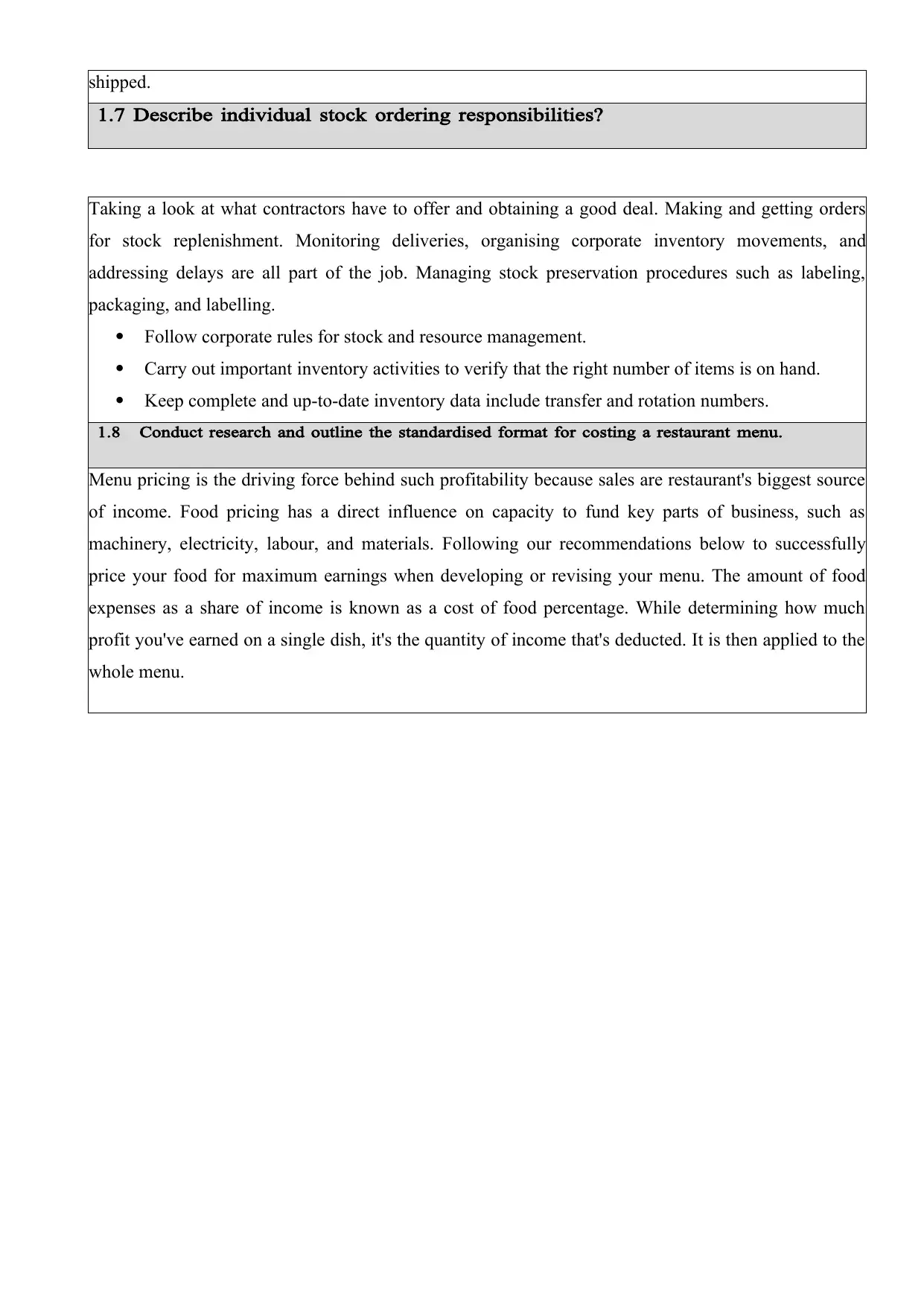
shipped.
1.7 Describe individual stock ordering responsibilities?
Taking a look at what contractors have to offer and obtaining a good deal. Making and getting orders
for stock replenishment. Monitoring deliveries, organising corporate inventory movements, and
addressing delays are all part of the job. Managing stock preservation procedures such as labeling,
packaging, and labelling.
Follow corporate rules for stock and resource management.
Carry out important inventory activities to verify that the right number of items is on hand.
Keep complete and up-to-date inventory data include transfer and rotation numbers.
1.8 Conduct research and outline the standardised format for costing a restaurant menu.
Menu pricing is the driving force behind such profitability because sales are restaurant's biggest source
of income. Food pricing has a direct influence on capacity to fund key parts of business, such as
machinery, electricity, labour, and materials. Following our recommendations below to successfully
price your food for maximum earnings when developing or revising your menu. The amount of food
expenses as a share of income is known as a cost of food percentage. While determining how much
profit you've earned on a single dish, it's the quantity of income that's deducted. It is then applied to the
whole menu.
1.7 Describe individual stock ordering responsibilities?
Taking a look at what contractors have to offer and obtaining a good deal. Making and getting orders
for stock replenishment. Monitoring deliveries, organising corporate inventory movements, and
addressing delays are all part of the job. Managing stock preservation procedures such as labeling,
packaging, and labelling.
Follow corporate rules for stock and resource management.
Carry out important inventory activities to verify that the right number of items is on hand.
Keep complete and up-to-date inventory data include transfer and rotation numbers.
1.8 Conduct research and outline the standardised format for costing a restaurant menu.
Menu pricing is the driving force behind such profitability because sales are restaurant's biggest source
of income. Food pricing has a direct influence on capacity to fund key parts of business, such as
machinery, electricity, labour, and materials. Following our recommendations below to successfully
price your food for maximum earnings when developing or revising your menu. The amount of food
expenses as a share of income is known as a cost of food percentage. While determining how much
profit you've earned on a single dish, it's the quantity of income that's deducted. It is then applied to the
whole menu.
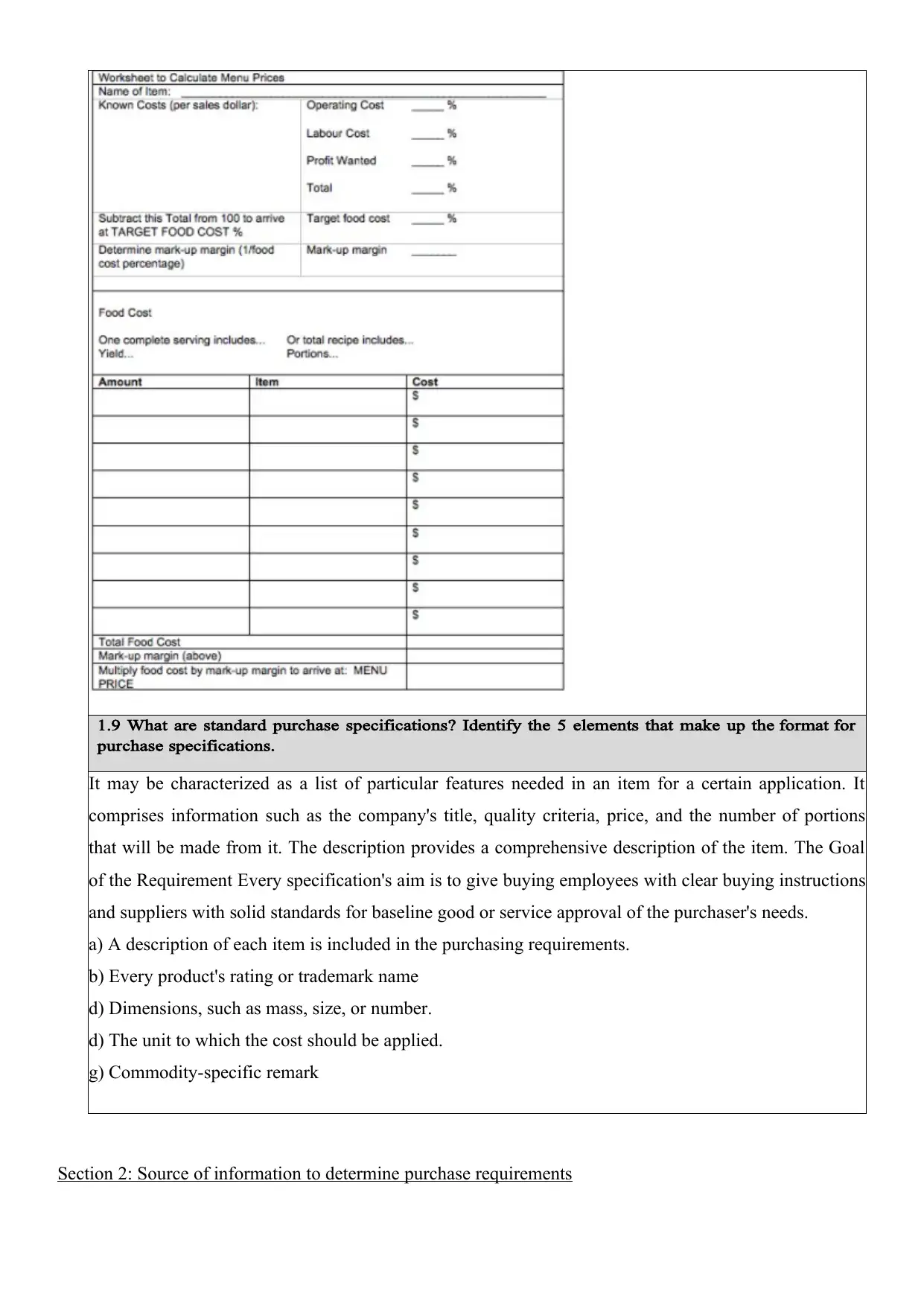
1.9 What are standard purchase specifications? Identify the 5 elements that make up the format for
purchase specifications.
It may be characterized as a list of particular features needed in an item for a certain application. It
comprises information such as the company's title, quality criteria, price, and the number of portions
that will be made from it. The description provides a comprehensive description of the item. The Goal
of the Requirement Every specification's aim is to give buying employees with clear buying instructions
and suppliers with solid standards for baseline good or service approval of the purchaser's needs.
a) A description of each item is included in the purchasing requirements.
b) Every product's rating or trademark name
d) Dimensions, such as mass, size, or number.
d) The unit to which the cost should be applied.
g) Commodity-specific remark
Section 2: Source of information to determine purchase requirements
purchase specifications.
It may be characterized as a list of particular features needed in an item for a certain application. It
comprises information such as the company's title, quality criteria, price, and the number of portions
that will be made from it. The description provides a comprehensive description of the item. The Goal
of the Requirement Every specification's aim is to give buying employees with clear buying instructions
and suppliers with solid standards for baseline good or service approval of the purchaser's needs.
a) A description of each item is included in the purchasing requirements.
b) Every product's rating or trademark name
d) Dimensions, such as mass, size, or number.
d) The unit to which the cost should be applied.
g) Commodity-specific remark
Section 2: Source of information to determine purchase requirements
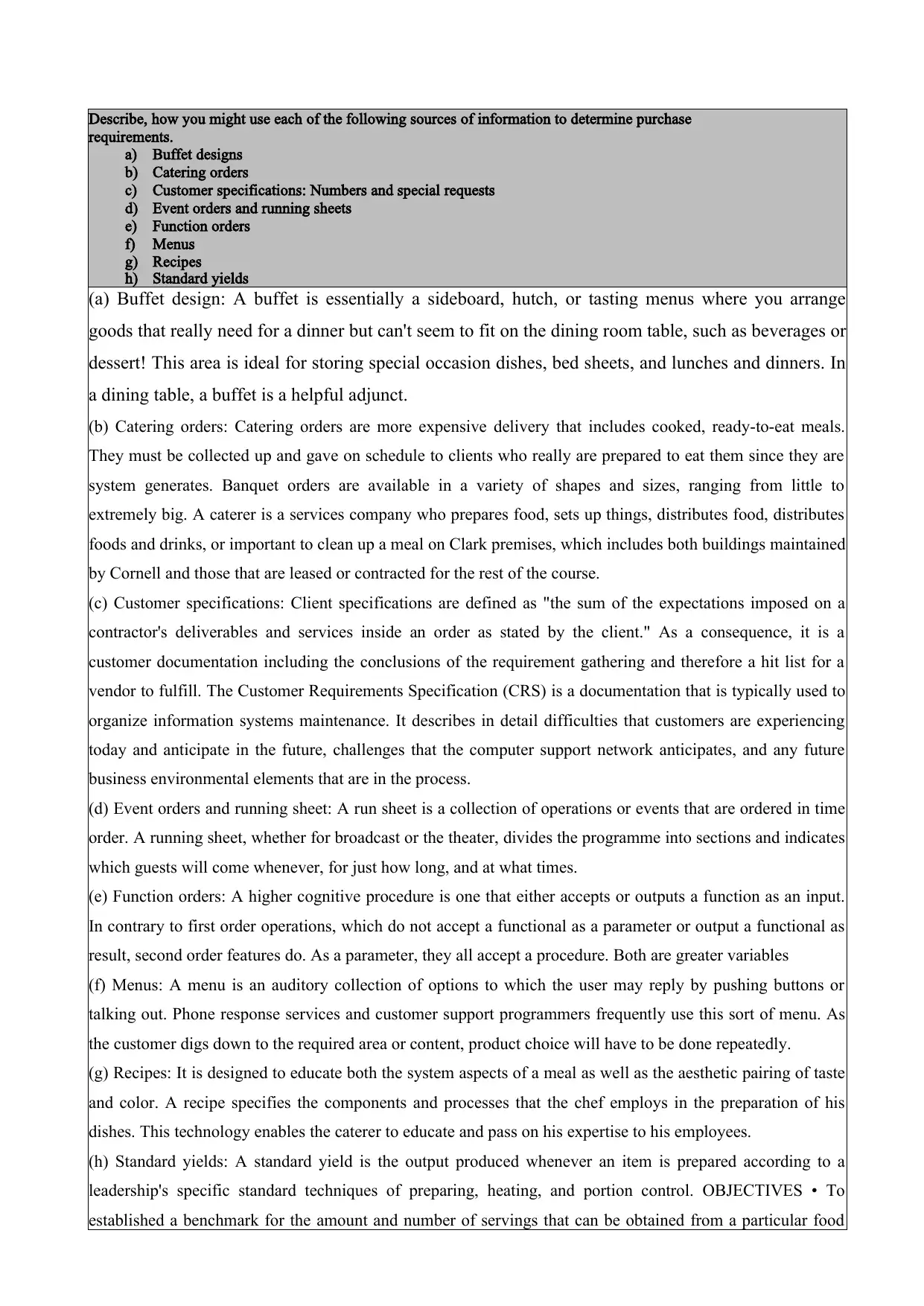
Describe, how you might use each of the following sources of information to determine purchase
requirements.
a) Buffet designs
b) Catering orders
c) Customer specifications: Numbers and special requests
d) Event orders and running sheets
e) Function orders
f) Menus
g) Recipes
h) Standard yields
(a) Buffet design: A buffet is essentially a sideboard, hutch, or tasting menus where you arrange
goods that really need for a dinner but can't seem to fit on the dining room table, such as beverages or
dessert! This area is ideal for storing special occasion dishes, bed sheets, and lunches and dinners. In
a dining table, a buffet is a helpful adjunct.
(b) Catering orders: Catering orders are more expensive delivery that includes cooked, ready-to-eat meals.
They must be collected up and gave on schedule to clients who really are prepared to eat them since they are
system generates. Banquet orders are available in a variety of shapes and sizes, ranging from little to
extremely big. A caterer is a services company who prepares food, sets up things, distributes food, distributes
foods and drinks, or important to clean up a meal on Clark premises, which includes both buildings maintained
by Cornell and those that are leased or contracted for the rest of the course.
(c) Customer specifications: Client specifications are defined as "the sum of the expectations imposed on a
contractor's deliverables and services inside an order as stated by the client." As a consequence, it is a
customer documentation including the conclusions of the requirement gathering and therefore a hit list for a
vendor to fulfill. The Customer Requirements Specification (CRS) is a documentation that is typically used to
organize information systems maintenance. It describes in detail difficulties that customers are experiencing
today and anticipate in the future, challenges that the computer support network anticipates, and any future
business environmental elements that are in the process.
(d) Event orders and running sheet: A run sheet is a collection of operations or events that are ordered in time
order. A running sheet, whether for broadcast or the theater, divides the programme into sections and indicates
which guests will come whenever, for just how long, and at what times.
(e) Function orders: A higher cognitive procedure is one that either accepts or outputs a function as an input.
In contrary to first order operations, which do not accept a functional as a parameter or output a functional as
result, second order features do. As a parameter, they all accept a procedure. Both are greater variables
(f) Menus: A menu is an auditory collection of options to which the user may reply by pushing buttons or
talking out. Phone response services and customer support programmers frequently use this sort of menu. As
the customer digs down to the required area or content, product choice will have to be done repeatedly.
(g) Recipes: It is designed to educate both the system aspects of a meal as well as the aesthetic pairing of taste
and color. A recipe specifies the components and processes that the chef employs in the preparation of his
dishes. This technology enables the caterer to educate and pass on his expertise to his employees.
(h) Standard yields: A standard yield is the output produced whenever an item is prepared according to a
leadership's specific standard techniques of preparing, heating, and portion control. OBJECTIVES • To
established a benchmark for the amount and number of servings that can be obtained from a particular food
requirements.
a) Buffet designs
b) Catering orders
c) Customer specifications: Numbers and special requests
d) Event orders and running sheets
e) Function orders
f) Menus
g) Recipes
h) Standard yields
(a) Buffet design: A buffet is essentially a sideboard, hutch, or tasting menus where you arrange
goods that really need for a dinner but can't seem to fit on the dining room table, such as beverages or
dessert! This area is ideal for storing special occasion dishes, bed sheets, and lunches and dinners. In
a dining table, a buffet is a helpful adjunct.
(b) Catering orders: Catering orders are more expensive delivery that includes cooked, ready-to-eat meals.
They must be collected up and gave on schedule to clients who really are prepared to eat them since they are
system generates. Banquet orders are available in a variety of shapes and sizes, ranging from little to
extremely big. A caterer is a services company who prepares food, sets up things, distributes food, distributes
foods and drinks, or important to clean up a meal on Clark premises, which includes both buildings maintained
by Cornell and those that are leased or contracted for the rest of the course.
(c) Customer specifications: Client specifications are defined as "the sum of the expectations imposed on a
contractor's deliverables and services inside an order as stated by the client." As a consequence, it is a
customer documentation including the conclusions of the requirement gathering and therefore a hit list for a
vendor to fulfill. The Customer Requirements Specification (CRS) is a documentation that is typically used to
organize information systems maintenance. It describes in detail difficulties that customers are experiencing
today and anticipate in the future, challenges that the computer support network anticipates, and any future
business environmental elements that are in the process.
(d) Event orders and running sheet: A run sheet is a collection of operations or events that are ordered in time
order. A running sheet, whether for broadcast or the theater, divides the programme into sections and indicates
which guests will come whenever, for just how long, and at what times.
(e) Function orders: A higher cognitive procedure is one that either accepts or outputs a function as an input.
In contrary to first order operations, which do not accept a functional as a parameter or output a functional as
result, second order features do. As a parameter, they all accept a procedure. Both are greater variables
(f) Menus: A menu is an auditory collection of options to which the user may reply by pushing buttons or
talking out. Phone response services and customer support programmers frequently use this sort of menu. As
the customer digs down to the required area or content, product choice will have to be done repeatedly.
(g) Recipes: It is designed to educate both the system aspects of a meal as well as the aesthetic pairing of taste
and color. A recipe specifies the components and processes that the chef employs in the preparation of his
dishes. This technology enables the caterer to educate and pass on his expertise to his employees.
(h) Standard yields: A standard yield is the output produced whenever an item is prepared according to a
leadership's specific standard techniques of preparing, heating, and portion control. OBJECTIVES • To
established a benchmark for the amount and number of servings that can be obtained from a particular food
Paraphrase This Document
Need a fresh take? Get an instant paraphrase of this document with our AI Paraphraser
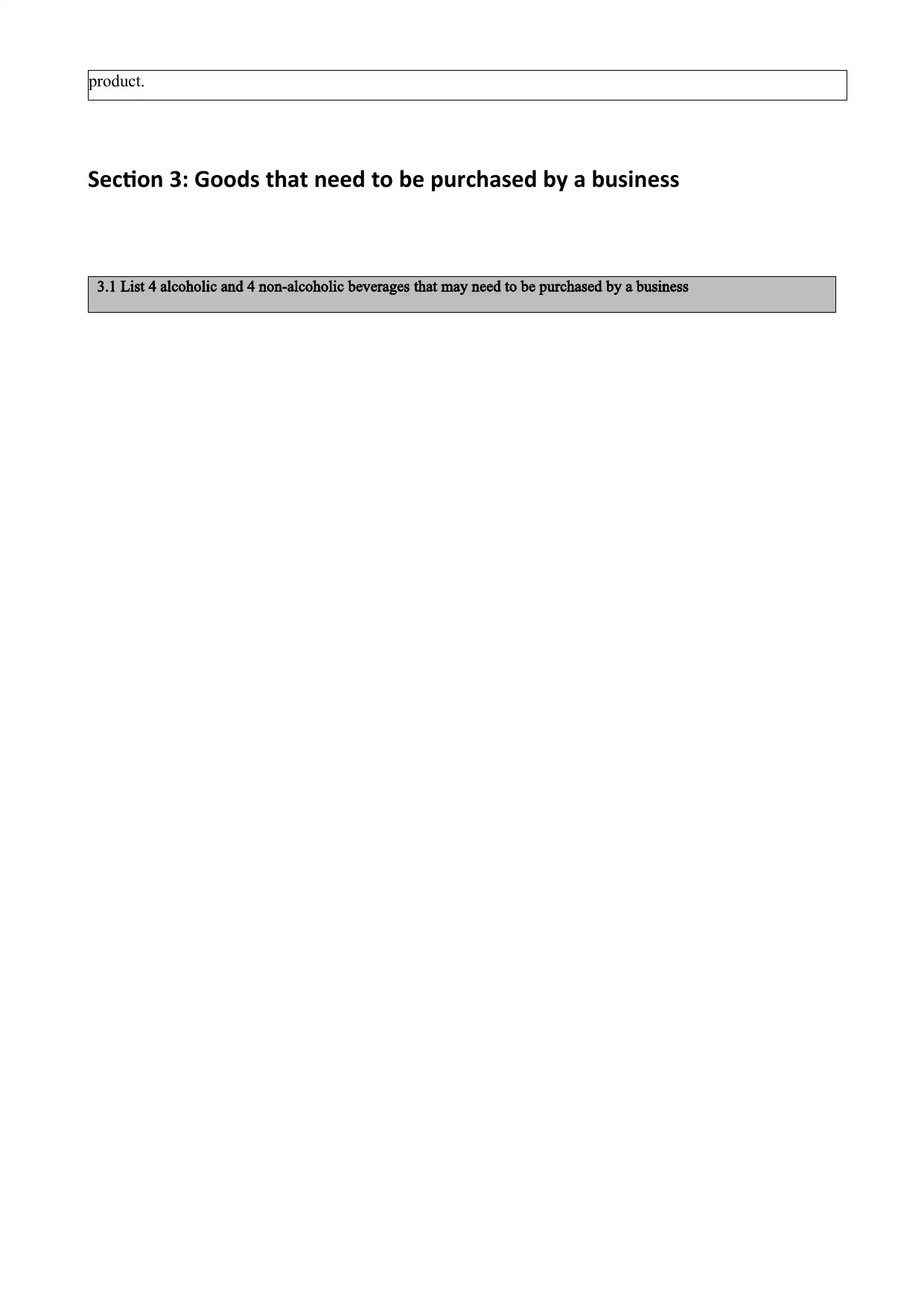
product.
Section 3: Goods that need to be purchased by a business
3.1 List 4 alcoholic and 4 non-alcoholic beverages that may need to be purchased by a business
Section 3: Goods that need to be purchased by a business
3.1 List 4 alcoholic and 4 non-alcoholic beverages that may need to be purchased by a business
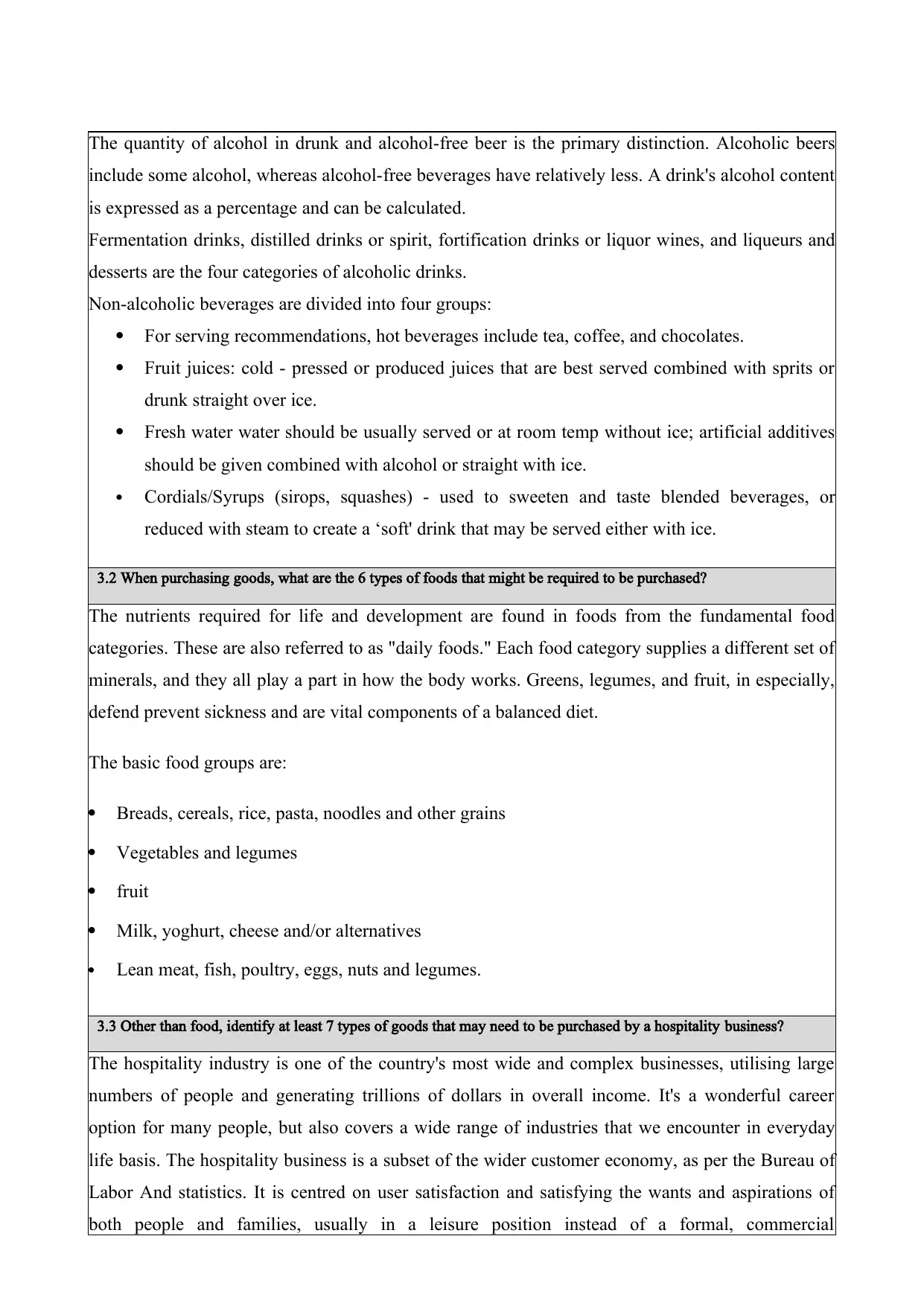
The quantity of alcohol in drunk and alcohol-free beer is the primary distinction. Alcoholic beers
include some alcohol, whereas alcohol-free beverages have relatively less. A drink's alcohol content
is expressed as a percentage and can be calculated.
Fermentation drinks, distilled drinks or spirit, fortification drinks or liquor wines, and liqueurs and
desserts are the four categories of alcoholic drinks.
Non-alcoholic beverages are divided into four groups:
For serving recommendations, hot beverages include tea, coffee, and chocolates.
Fruit juices: cold - pressed or produced juices that are best served combined with sprits or
drunk straight over ice.
Fresh water water should be usually served or at room temp without ice; artificial additives
should be given combined with alcohol or straight with ice.
Cordials/Syrups (sirops, squashes) - used to sweeten and taste blended beverages, or
reduced with steam to create a ‘soft' drink that may be served either with ice.
3.2 When purchasing goods, what are the 6 types of foods that might be required to be purchased?
The nutrients required for life and development are found in foods from the fundamental food
categories. These are also referred to as "daily foods." Each food category supplies a different set of
minerals, and they all play a part in how the body works. Greens, legumes, and fruit, in especially,
defend prevent sickness and are vital components of a balanced diet.
The basic food groups are:
Breads, cereals, rice, pasta, noodles and other grains
Vegetables and legumes
fruit
Milk, yoghurt, cheese and/or alternatives
Lean meat, fish, poultry, eggs, nuts and legumes.
3.3 Other than food, identify at least 7 types of goods that may need to be purchased by a hospitality business?
The hospitality industry is one of the country's most wide and complex businesses, utilising large
numbers of people and generating trillions of dollars in overall income. It's a wonderful career
option for many people, but also covers a wide range of industries that we encounter in everyday
life basis. The hospitality business is a subset of the wider customer economy, as per the Bureau of
Labor And statistics. It is centred on user satisfaction and satisfying the wants and aspirations of
both people and families, usually in a leisure position instead of a formal, commercial
include some alcohol, whereas alcohol-free beverages have relatively less. A drink's alcohol content
is expressed as a percentage and can be calculated.
Fermentation drinks, distilled drinks or spirit, fortification drinks or liquor wines, and liqueurs and
desserts are the four categories of alcoholic drinks.
Non-alcoholic beverages are divided into four groups:
For serving recommendations, hot beverages include tea, coffee, and chocolates.
Fruit juices: cold - pressed or produced juices that are best served combined with sprits or
drunk straight over ice.
Fresh water water should be usually served or at room temp without ice; artificial additives
should be given combined with alcohol or straight with ice.
Cordials/Syrups (sirops, squashes) - used to sweeten and taste blended beverages, or
reduced with steam to create a ‘soft' drink that may be served either with ice.
3.2 When purchasing goods, what are the 6 types of foods that might be required to be purchased?
The nutrients required for life and development are found in foods from the fundamental food
categories. These are also referred to as "daily foods." Each food category supplies a different set of
minerals, and they all play a part in how the body works. Greens, legumes, and fruit, in especially,
defend prevent sickness and are vital components of a balanced diet.
The basic food groups are:
Breads, cereals, rice, pasta, noodles and other grains
Vegetables and legumes
fruit
Milk, yoghurt, cheese and/or alternatives
Lean meat, fish, poultry, eggs, nuts and legumes.
3.3 Other than food, identify at least 7 types of goods that may need to be purchased by a hospitality business?
The hospitality industry is one of the country's most wide and complex businesses, utilising large
numbers of people and generating trillions of dollars in overall income. It's a wonderful career
option for many people, but also covers a wide range of industries that we encounter in everyday
life basis. The hospitality business is a subset of the wider customer economy, as per the Bureau of
Labor And statistics. It is centred on user satisfaction and satisfying the wants and aspirations of
both people and families, usually in a leisure position instead of a formal, commercial
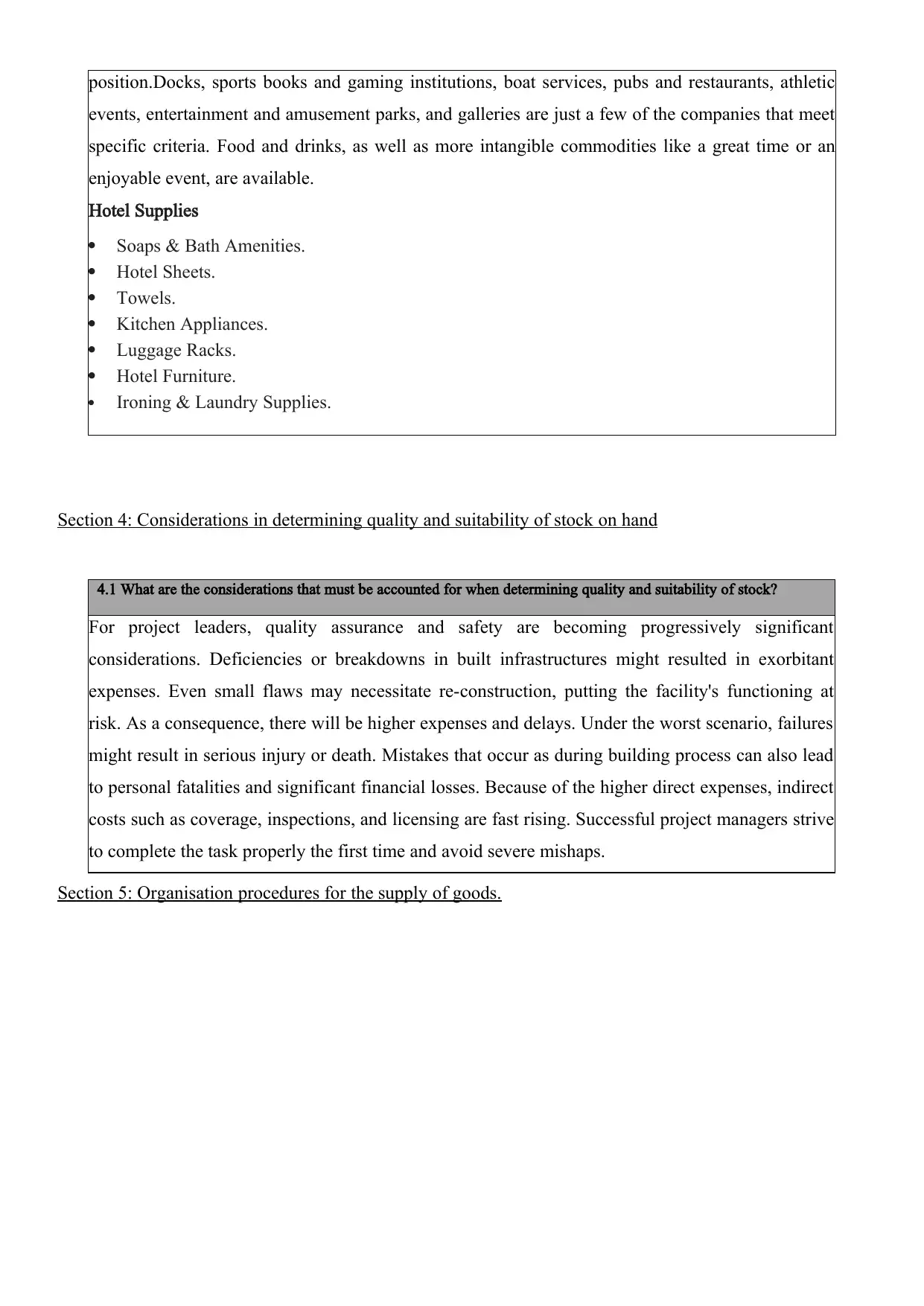
position.Docks, sports books and gaming institutions, boat services, pubs and restaurants, athletic
events, entertainment and amusement parks, and galleries are just a few of the companies that meet
specific criteria. Food and drinks, as well as more intangible commodities like a great time or an
enjoyable event, are available.
Hotel Supplies
Soaps & Bath Amenities.
Hotel Sheets.
Towels.
Kitchen Appliances.
Luggage Racks.
Hotel Furniture.
Ironing & Laundry Supplies.
Section 4: Considerations in determining quality and suitability of stock on hand
4.1 What are the considerations that must be accounted for when determining quality and suitability of stock?
For project leaders, quality assurance and safety are becoming progressively significant
considerations. Deficiencies or breakdowns in built infrastructures might resulted in exorbitant
expenses. Even small flaws may necessitate re-construction, putting the facility's functioning at
risk. As a consequence, there will be higher expenses and delays. Under the worst scenario, failures
might result in serious injury or death. Mistakes that occur as during building process can also lead
to personal fatalities and significant financial losses. Because of the higher direct expenses, indirect
costs such as coverage, inspections, and licensing are fast rising. Successful project managers strive
to complete the task properly the first time and avoid severe mishaps.
Section 5: Organisation procedures for the supply of goods.
events, entertainment and amusement parks, and galleries are just a few of the companies that meet
specific criteria. Food and drinks, as well as more intangible commodities like a great time or an
enjoyable event, are available.
Hotel Supplies
Soaps & Bath Amenities.
Hotel Sheets.
Towels.
Kitchen Appliances.
Luggage Racks.
Hotel Furniture.
Ironing & Laundry Supplies.
Section 4: Considerations in determining quality and suitability of stock on hand
4.1 What are the considerations that must be accounted for when determining quality and suitability of stock?
For project leaders, quality assurance and safety are becoming progressively significant
considerations. Deficiencies or breakdowns in built infrastructures might resulted in exorbitant
expenses. Even small flaws may necessitate re-construction, putting the facility's functioning at
risk. As a consequence, there will be higher expenses and delays. Under the worst scenario, failures
might result in serious injury or death. Mistakes that occur as during building process can also lead
to personal fatalities and significant financial losses. Because of the higher direct expenses, indirect
costs such as coverage, inspections, and licensing are fast rising. Successful project managers strive
to complete the task properly the first time and avoid severe mishaps.
Section 5: Organisation procedures for the supply of goods.
Secure Best Marks with AI Grader
Need help grading? Try our AI Grader for instant feedback on your assignments.
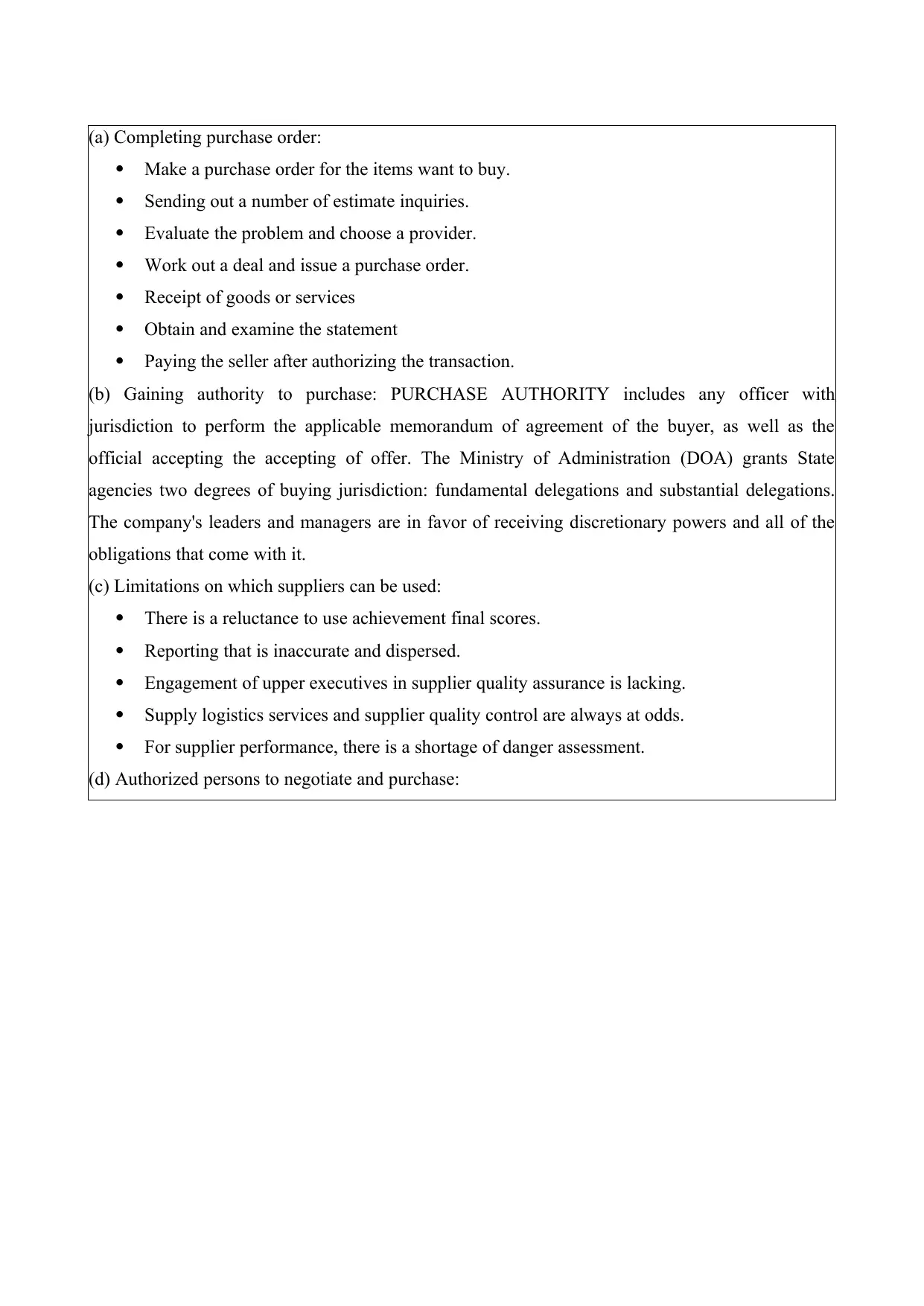
(a) Completing purchase order:
Make a purchase order for the items want to buy.
Sending out a number of estimate inquiries.
Evaluate the problem and choose a provider.
Work out a deal and issue a purchase order.
Receipt of goods or services
Obtain and examine the statement
Paying the seller after authorizing the transaction.
(b) Gaining authority to purchase: PURCHASE AUTHORITY includes any officer with
jurisdiction to perform the applicable memorandum of agreement of the buyer, as well as the
official accepting the accepting of offer. The Ministry of Administration (DOA) grants State
agencies two degrees of buying jurisdiction: fundamental delegations and substantial delegations.
The company's leaders and managers are in favor of receiving discretionary powers and all of the
obligations that come with it.
(c) Limitations on which suppliers can be used:
There is a reluctance to use achievement final scores.
Reporting that is inaccurate and dispersed.
Engagement of upper executives in supplier quality assurance is lacking.
Supply logistics services and supplier quality control are always at odds.
For supplier performance, there is a shortage of danger assessment.
(d) Authorized persons to negotiate and purchase:
Make a purchase order for the items want to buy.
Sending out a number of estimate inquiries.
Evaluate the problem and choose a provider.
Work out a deal and issue a purchase order.
Receipt of goods or services
Obtain and examine the statement
Paying the seller after authorizing the transaction.
(b) Gaining authority to purchase: PURCHASE AUTHORITY includes any officer with
jurisdiction to perform the applicable memorandum of agreement of the buyer, as well as the
official accepting the accepting of offer. The Ministry of Administration (DOA) grants State
agencies two degrees of buying jurisdiction: fundamental delegations and substantial delegations.
The company's leaders and managers are in favor of receiving discretionary powers and all of the
obligations that come with it.
(c) Limitations on which suppliers can be used:
There is a reluctance to use achievement final scores.
Reporting that is inaccurate and dispersed.
Engagement of upper executives in supplier quality assurance is lacking.
Supply logistics services and supplier quality control are always at odds.
For supplier performance, there is a shortage of danger assessment.
(d) Authorized persons to negotiate and purchase:
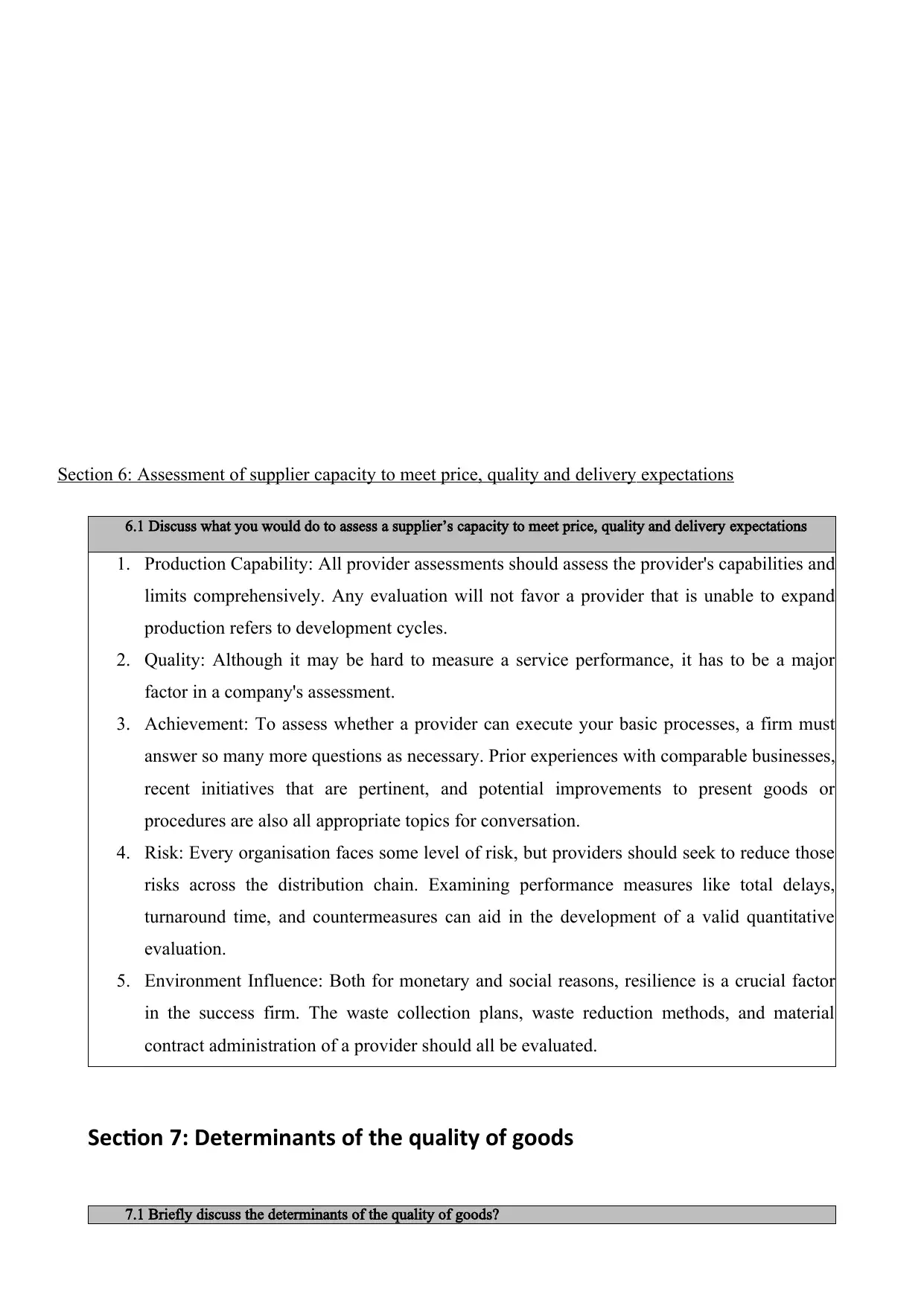
Section 6: Assessment of supplier capacity to meet price, quality and delivery expectations
6.1 Discuss what you would do to assess a supplier’s capacity to meet price, quality and delivery expectations
1. Production Capability: All provider assessments should assess the provider's capabilities and
limits comprehensively. Any evaluation will not favor a provider that is unable to expand
production refers to development cycles.
2. Quality: Although it may be hard to measure a service performance, it has to be a major
factor in a company's assessment.
3. Achievement: To assess whether a provider can execute your basic processes, a firm must
answer so many more questions as necessary. Prior experiences with comparable businesses,
recent initiatives that are pertinent, and potential improvements to present goods or
procedures are also all appropriate topics for conversation.
4. Risk: Every organisation faces some level of risk, but providers should seek to reduce those
risks across the distribution chain. Examining performance measures like total delays,
turnaround time, and countermeasures can aid in the development of a valid quantitative
evaluation.
5. Environment Influence: Both for monetary and social reasons, resilience is a crucial factor
in the success firm. The waste collection plans, waste reduction methods, and material
contract administration of a provider should all be evaluated.
Section 7: Determinants of the quality of goods
7.1 Briefly discuss the determinants of the quality of goods?
6.1 Discuss what you would do to assess a supplier’s capacity to meet price, quality and delivery expectations
1. Production Capability: All provider assessments should assess the provider's capabilities and
limits comprehensively. Any evaluation will not favor a provider that is unable to expand
production refers to development cycles.
2. Quality: Although it may be hard to measure a service performance, it has to be a major
factor in a company's assessment.
3. Achievement: To assess whether a provider can execute your basic processes, a firm must
answer so many more questions as necessary. Prior experiences with comparable businesses,
recent initiatives that are pertinent, and potential improvements to present goods or
procedures are also all appropriate topics for conversation.
4. Risk: Every organisation faces some level of risk, but providers should seek to reduce those
risks across the distribution chain. Examining performance measures like total delays,
turnaround time, and countermeasures can aid in the development of a valid quantitative
evaluation.
5. Environment Influence: Both for monetary and social reasons, resilience is a crucial factor
in the success firm. The waste collection plans, waste reduction methods, and material
contract administration of a provider should all be evaluated.
Section 7: Determinants of the quality of goods
7.1 Briefly discuss the determinants of the quality of goods?
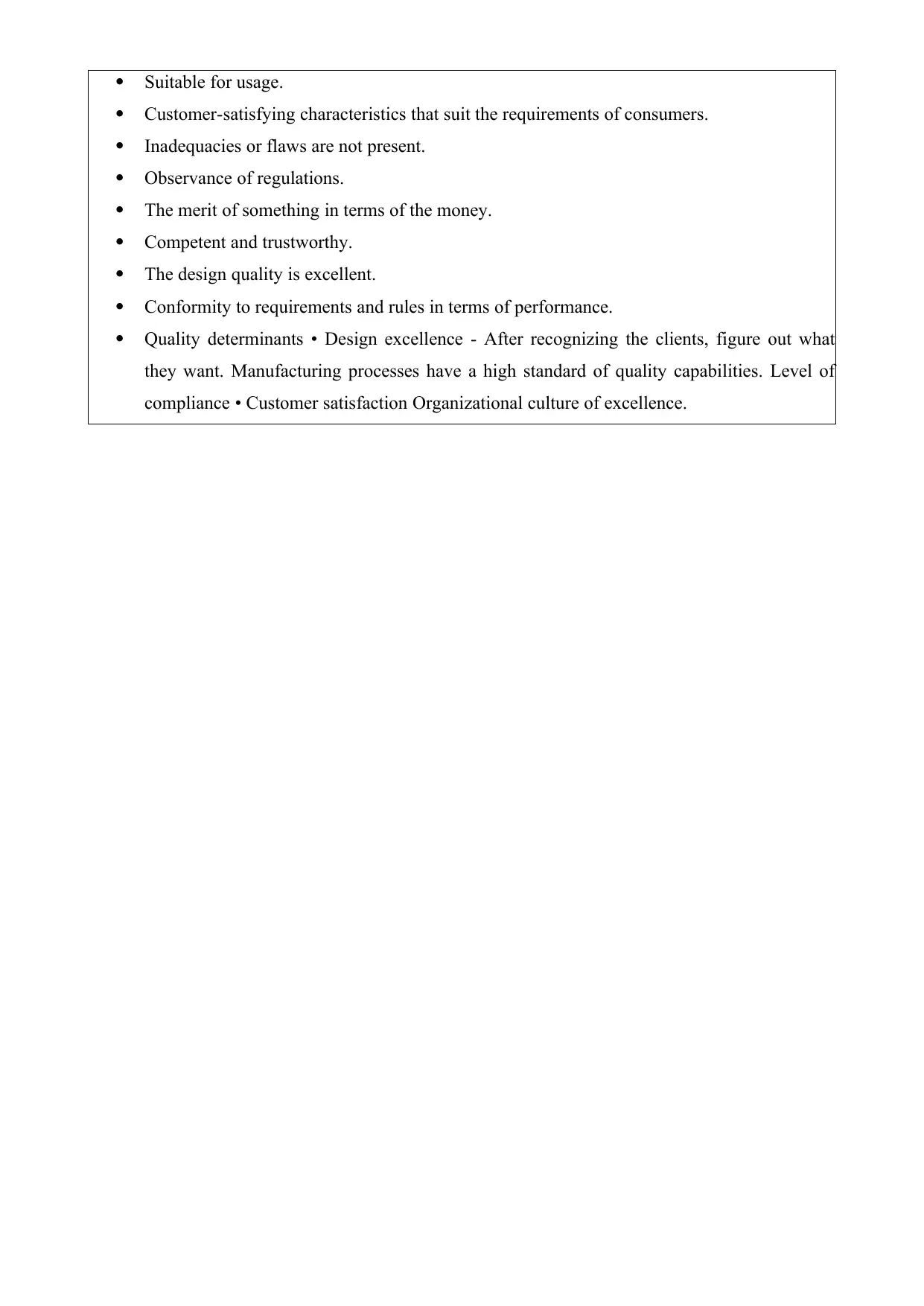
Suitable for usage.
Customer-satisfying characteristics that suit the requirements of consumers.
Inadequacies or flaws are not present.
Observance of regulations.
The merit of something in terms of the money.
Competent and trustworthy.
The design quality is excellent.
Conformity to requirements and rules in terms of performance.
Quality determinants • Design excellence - After recognizing the clients, figure out what
they want. Manufacturing processes have a high standard of quality capabilities. Level of
compliance • Customer satisfaction Organizational culture of excellence.
Customer-satisfying characteristics that suit the requirements of consumers.
Inadequacies or flaws are not present.
Observance of regulations.
The merit of something in terms of the money.
Competent and trustworthy.
The design quality is excellent.
Conformity to requirements and rules in terms of performance.
Quality determinants • Design excellence - After recognizing the clients, figure out what
they want. Manufacturing processes have a high standard of quality capabilities. Level of
compliance • Customer satisfaction Organizational culture of excellence.
Paraphrase This Document
Need a fresh take? Get an instant paraphrase of this document with our AI Paraphraser
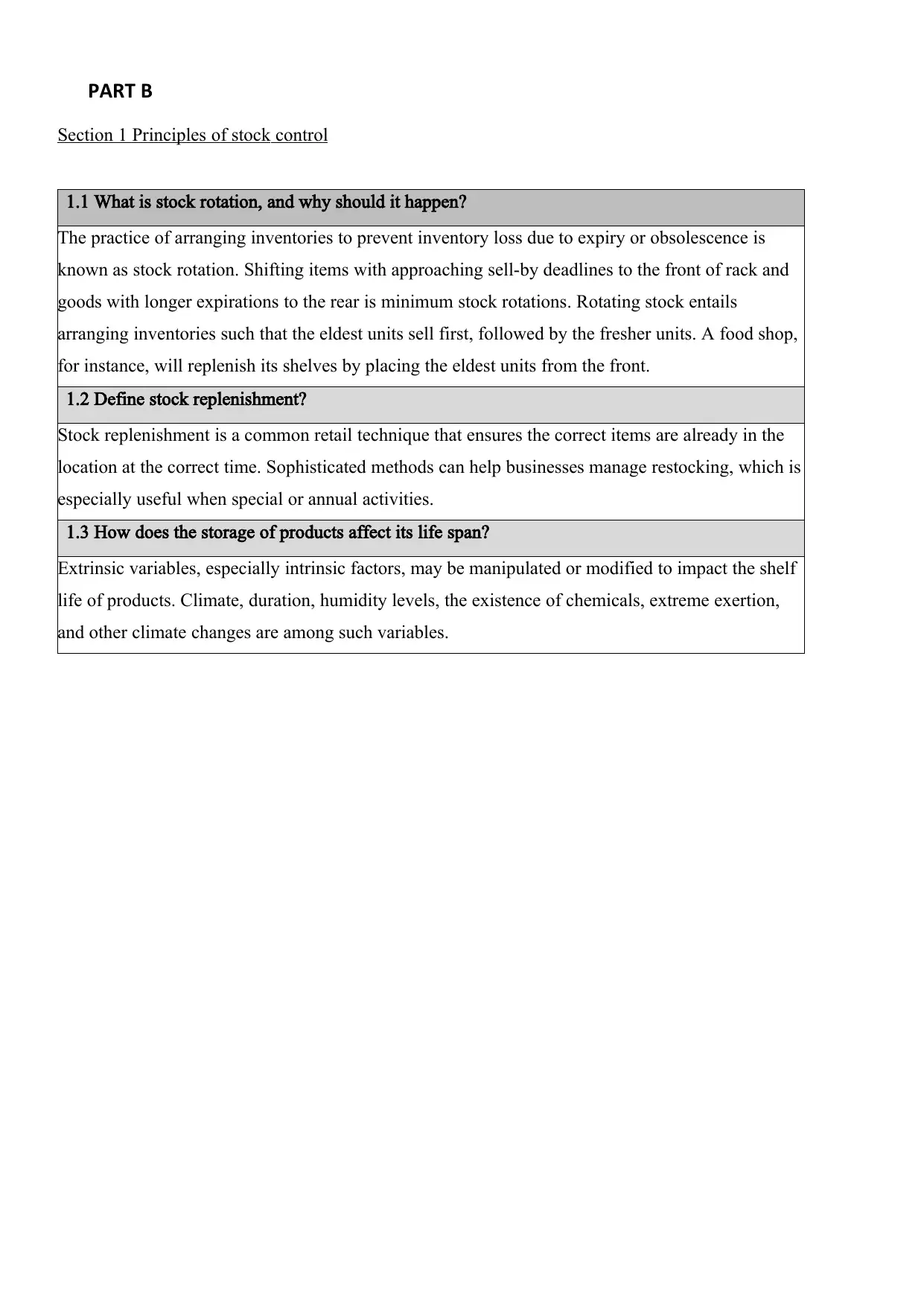
PART B
Section 1 Principles of stock control
1.1 What is stock rotation, and why should it happen?
The practice of arranging inventories to prevent inventory loss due to expiry or obsolescence is
known as stock rotation. Shifting items with approaching sell-by deadlines to the front of rack and
goods with longer expirations to the rear is minimum stock rotations. Rotating stock entails
arranging inventories such that the eldest units sell first, followed by the fresher units. A food shop,
for instance, will replenish its shelves by placing the eldest units from the front.
1.2 Define stock replenishment?
Stock replenishment is a common retail technique that ensures the correct items are already in the
location at the correct time. Sophisticated methods can help businesses manage restocking, which is
especially useful when special or annual activities.
1.3 How does the storage of products affect its life span?
Extrinsic variables, especially intrinsic factors, may be manipulated or modified to impact the shelf
life of products. Climate, duration, humidity levels, the existence of chemicals, extreme exertion,
and other climate changes are among such variables.
Section 1 Principles of stock control
1.1 What is stock rotation, and why should it happen?
The practice of arranging inventories to prevent inventory loss due to expiry or obsolescence is
known as stock rotation. Shifting items with approaching sell-by deadlines to the front of rack and
goods with longer expirations to the rear is minimum stock rotations. Rotating stock entails
arranging inventories such that the eldest units sell first, followed by the fresher units. A food shop,
for instance, will replenish its shelves by placing the eldest units from the front.
1.2 Define stock replenishment?
Stock replenishment is a common retail technique that ensures the correct items are already in the
location at the correct time. Sophisticated methods can help businesses manage restocking, which is
especially useful when special or annual activities.
1.3 How does the storage of products affect its life span?
Extrinsic variables, especially intrinsic factors, may be manipulated or modified to impact the shelf
life of products. Climate, duration, humidity levels, the existence of chemicals, extreme exertion,
and other climate changes are among such variables.
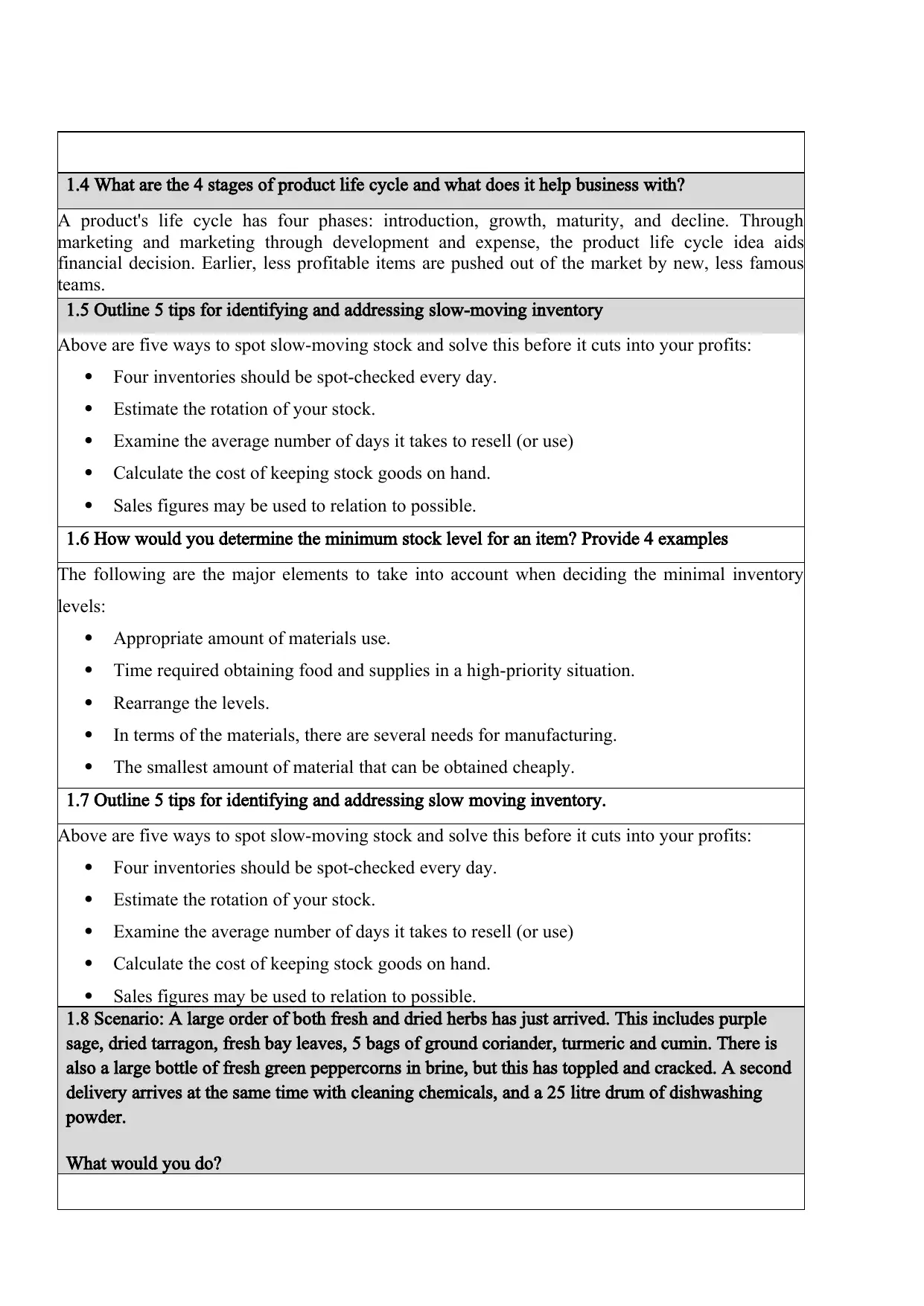
1.4 What are the 4 stages of product life cycle and what does it help business with?
A product's life cycle has four phases: introduction, growth, maturity, and decline. Through
marketing and marketing through development and expense, the product life cycle idea aids
financial decision. Earlier, less profitable items are pushed out of the market by new, less famous
teams.
1.5 Outline 5 tips for identifying and addressing slow-moving inventory
Above are five ways to spot slow-moving stock and solve this before it cuts into your profits:
Four inventories should be spot-checked every day.
Estimate the rotation of your stock.
Examine the average number of days it takes to resell (or use)
Calculate the cost of keeping stock goods on hand.
Sales figures may be used to relation to possible.
1.6 How would you determine the minimum stock level for an item? Provide 4 examples
The following are the major elements to take into account when deciding the minimal inventory
levels:
Appropriate amount of materials use.
Time required obtaining food and supplies in a high-priority situation.
Rearrange the levels.
In terms of the materials, there are several needs for manufacturing.
The smallest amount of material that can be obtained cheaply.
1.7 Outline 5 tips for identifying and addressing slow moving inventory.
Above are five ways to spot slow-moving stock and solve this before it cuts into your profits:
Four inventories should be spot-checked every day.
Estimate the rotation of your stock.
Examine the average number of days it takes to resell (or use)
Calculate the cost of keeping stock goods on hand.
Sales figures may be used to relation to possible.
1.8 Scenario: A large order of both fresh and dried herbs has just arrived. This includes purple
sage, dried tarragon, fresh bay leaves, 5 bags of ground coriander, turmeric and cumin. There is
also a large bottle of fresh green peppercorns in brine, but this has toppled and cracked. A second
delivery arrives at the same time with cleaning chemicals, and a 25 litre drum of dishwashing
powder.
What would you do?
A product's life cycle has four phases: introduction, growth, maturity, and decline. Through
marketing and marketing through development and expense, the product life cycle idea aids
financial decision. Earlier, less profitable items are pushed out of the market by new, less famous
teams.
1.5 Outline 5 tips for identifying and addressing slow-moving inventory
Above are five ways to spot slow-moving stock and solve this before it cuts into your profits:
Four inventories should be spot-checked every day.
Estimate the rotation of your stock.
Examine the average number of days it takes to resell (or use)
Calculate the cost of keeping stock goods on hand.
Sales figures may be used to relation to possible.
1.6 How would you determine the minimum stock level for an item? Provide 4 examples
The following are the major elements to take into account when deciding the minimal inventory
levels:
Appropriate amount of materials use.
Time required obtaining food and supplies in a high-priority situation.
Rearrange the levels.
In terms of the materials, there are several needs for manufacturing.
The smallest amount of material that can be obtained cheaply.
1.7 Outline 5 tips for identifying and addressing slow moving inventory.
Above are five ways to spot slow-moving stock and solve this before it cuts into your profits:
Four inventories should be spot-checked every day.
Estimate the rotation of your stock.
Examine the average number of days it takes to resell (or use)
Calculate the cost of keeping stock goods on hand.
Sales figures may be used to relation to possible.
1.8 Scenario: A large order of both fresh and dried herbs has just arrived. This includes purple
sage, dried tarragon, fresh bay leaves, 5 bags of ground coriander, turmeric and cumin. There is
also a large bottle of fresh green peppercorns in brine, but this has toppled and cracked. A second
delivery arrives at the same time with cleaning chemicals, and a 25 litre drum of dishwashing
powder.
What would you do?
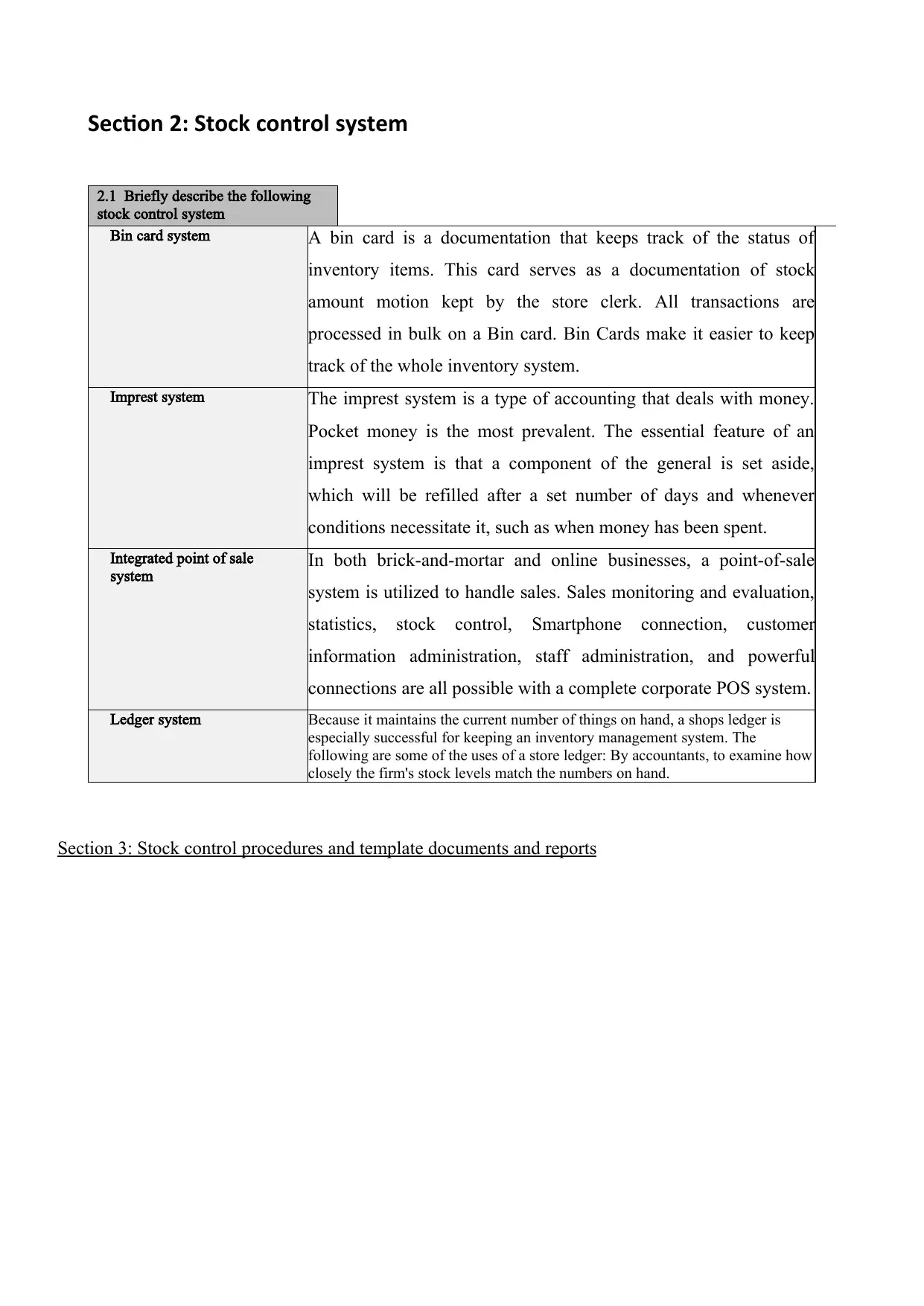
Section 2: Stock control system
2.1 Briefly describe the following
stock control system
Bin card system A bin card is a documentation that keeps track of the status of
inventory items. This card serves as a documentation of stock
amount motion kept by the store clerk. All transactions are
processed in bulk on a Bin card. Bin Cards make it easier to keep
track of the whole inventory system.
Imprest system The imprest system is a type of accounting that deals with money.
Pocket money is the most prevalent. The essential feature of an
imprest system is that a component of the general is set aside,
which will be refilled after a set number of days and whenever
conditions necessitate it, such as when money has been spent.
Integrated point of sale
system In both brick-and-mortar and online businesses, a point-of-sale
system is utilized to handle sales. Sales monitoring and evaluation,
statistics, stock control, Smartphone connection, customer
information administration, staff administration, and powerful
connections are all possible with a complete corporate POS system.
Ledger system Because it maintains the current number of things on hand, a shops ledger is
especially successful for keeping an inventory management system. The
following are some of the uses of a store ledger: By accountants, to examine how
closely the firm's stock levels match the numbers on hand.
Section 3: Stock control procedures and template documents and reports
2.1 Briefly describe the following
stock control system
Bin card system A bin card is a documentation that keeps track of the status of
inventory items. This card serves as a documentation of stock
amount motion kept by the store clerk. All transactions are
processed in bulk on a Bin card. Bin Cards make it easier to keep
track of the whole inventory system.
Imprest system The imprest system is a type of accounting that deals with money.
Pocket money is the most prevalent. The essential feature of an
imprest system is that a component of the general is set aside,
which will be refilled after a set number of days and whenever
conditions necessitate it, such as when money has been spent.
Integrated point of sale
system In both brick-and-mortar and online businesses, a point-of-sale
system is utilized to handle sales. Sales monitoring and evaluation,
statistics, stock control, Smartphone connection, customer
information administration, staff administration, and powerful
connections are all possible with a complete corporate POS system.
Ledger system Because it maintains the current number of things on hand, a shops ledger is
especially successful for keeping an inventory management system. The
following are some of the uses of a store ledger: By accountants, to examine how
closely the firm's stock levels match the numbers on hand.
Section 3: Stock control procedures and template documents and reports
Secure Best Marks with AI Grader
Need help grading? Try our AI Grader for instant feedback on your assignments.
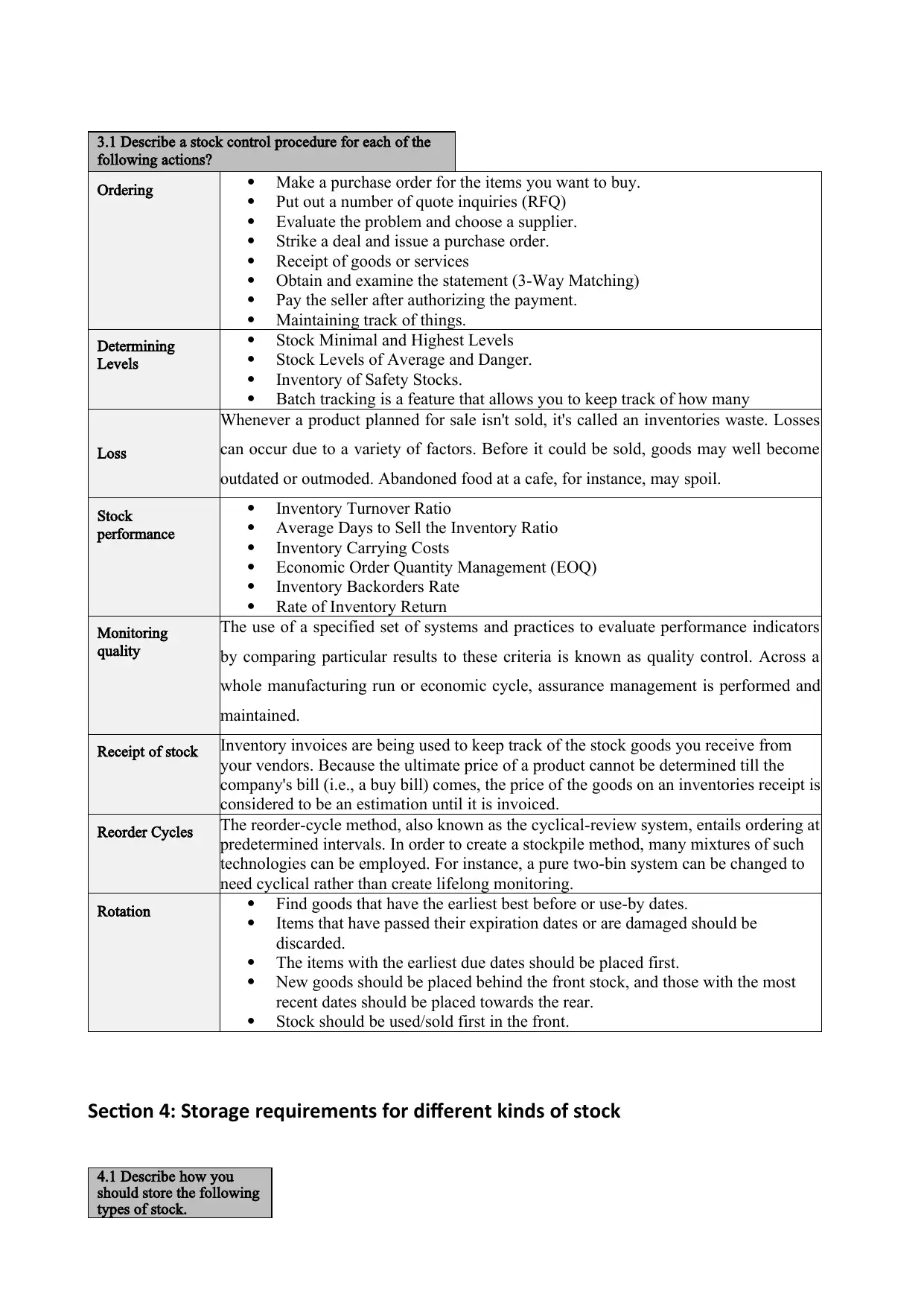
3.1 Describe a stock control procedure for each of the
following actions?
Ordering Make a purchase order for the items you want to buy.
Put out a number of quote inquiries (RFQ)
Evaluate the problem and choose a supplier.
Strike a deal and issue a purchase order.
Receipt of goods or services
Obtain and examine the statement (3-Way Matching)
Pay the seller after authorizing the payment.
Maintaining track of things.
Determining
Levels
Stock Minimal and Highest Levels
Stock Levels of Average and Danger.
Inventory of Safety Stocks.
Batch tracking is a feature that allows you to keep track of how many
Loss
Whenever a product planned for sale isn't sold, it's called an inventories waste. Losses
can occur due to a variety of factors. Before it could be sold, goods may well become
outdated or outmoded. Abandoned food at a cafe, for instance, may spoil.
Stock
performance
Inventory Turnover Ratio
Average Days to Sell the Inventory Ratio
Inventory Carrying Costs
Economic Order Quantity Management (EOQ)
Inventory Backorders Rate
Rate of Inventory Return
Monitoring
quality
The use of a specified set of systems and practices to evaluate performance indicators
by comparing particular results to these criteria is known as quality control. Across a
whole manufacturing run or economic cycle, assurance management is performed and
maintained.
Receipt of stock Inventory invoices are being used to keep track of the stock goods you receive from
your vendors. Because the ultimate price of a product cannot be determined till the
company's bill (i.e., a buy bill) comes, the price of the goods on an inventories receipt is
considered to be an estimation until it is invoiced.
Reorder Cycles The reorder-cycle method, also known as the cyclical-review system, entails ordering at
predetermined intervals. In order to create a stockpile method, many mixtures of such
technologies can be employed. For instance, a pure two-bin system can be changed to
need cyclical rather than create lifelong monitoring.
Rotation Find goods that have the earliest best before or use-by dates.
Items that have passed their expiration dates or are damaged should be
discarded.
The items with the earliest due dates should be placed first.
New goods should be placed behind the front stock, and those with the most
recent dates should be placed towards the rear.
Stock should be used/sold first in the front.
Section 4: Storage requirements for different kinds of stock
4.1 Describe how you
should store the following
types of stock.
following actions?
Ordering Make a purchase order for the items you want to buy.
Put out a number of quote inquiries (RFQ)
Evaluate the problem and choose a supplier.
Strike a deal and issue a purchase order.
Receipt of goods or services
Obtain and examine the statement (3-Way Matching)
Pay the seller after authorizing the payment.
Maintaining track of things.
Determining
Levels
Stock Minimal and Highest Levels
Stock Levels of Average and Danger.
Inventory of Safety Stocks.
Batch tracking is a feature that allows you to keep track of how many
Loss
Whenever a product planned for sale isn't sold, it's called an inventories waste. Losses
can occur due to a variety of factors. Before it could be sold, goods may well become
outdated or outmoded. Abandoned food at a cafe, for instance, may spoil.
Stock
performance
Inventory Turnover Ratio
Average Days to Sell the Inventory Ratio
Inventory Carrying Costs
Economic Order Quantity Management (EOQ)
Inventory Backorders Rate
Rate of Inventory Return
Monitoring
quality
The use of a specified set of systems and practices to evaluate performance indicators
by comparing particular results to these criteria is known as quality control. Across a
whole manufacturing run or economic cycle, assurance management is performed and
maintained.
Receipt of stock Inventory invoices are being used to keep track of the stock goods you receive from
your vendors. Because the ultimate price of a product cannot be determined till the
company's bill (i.e., a buy bill) comes, the price of the goods on an inventories receipt is
considered to be an estimation until it is invoiced.
Reorder Cycles The reorder-cycle method, also known as the cyclical-review system, entails ordering at
predetermined intervals. In order to create a stockpile method, many mixtures of such
technologies can be employed. For instance, a pure two-bin system can be changed to
need cyclical rather than create lifelong monitoring.
Rotation Find goods that have the earliest best before or use-by dates.
Items that have passed their expiration dates or are damaged should be
discarded.
The items with the earliest due dates should be placed first.
New goods should be placed behind the front stock, and those with the most
recent dates should be placed towards the rear.
Stock should be used/sold first in the front.
Section 4: Storage requirements for different kinds of stock
4.1 Describe how you
should store the following
types of stock.
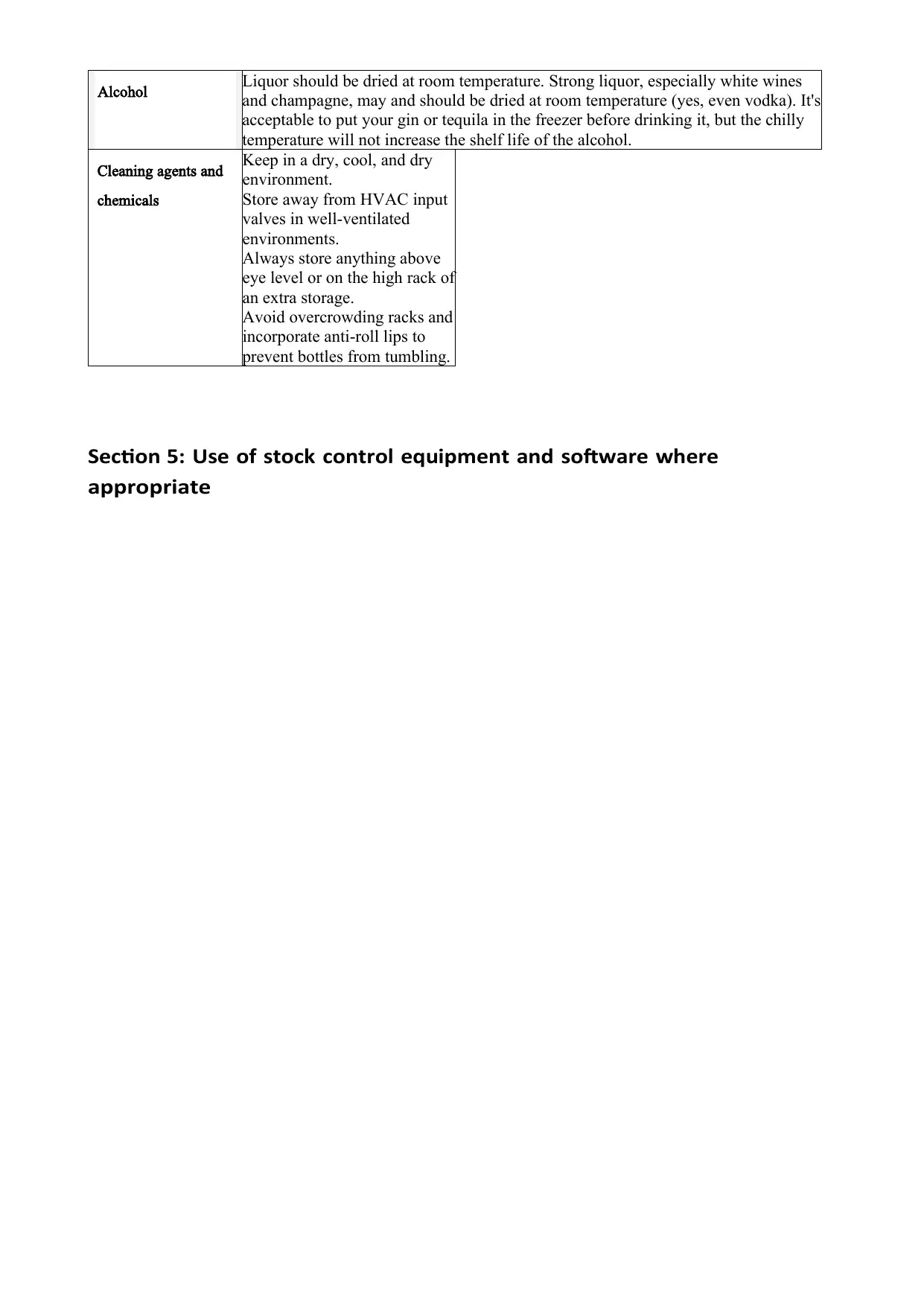
Alcohol Liquor should be dried at room temperature. Strong liquor, especially white wines
and champagne, may and should be dried at room temperature (yes, even vodka). It's
acceptable to put your gin or tequila in the freezer before drinking it, but the chilly
temperature will not increase the shelf life of the alcohol.
Cleaning agents and
chemicals
Keep in a dry, cool, and dry
environment.
Store away from HVAC input
valves in well-ventilated
environments.
Always store anything above
eye level or on the high rack of
an extra storage.
Avoid overcrowding racks and
incorporate anti-roll lips to
prevent bottles from tumbling.
Section 5: Use of stock control equipment and software where
appropriate
and champagne, may and should be dried at room temperature (yes, even vodka). It's
acceptable to put your gin or tequila in the freezer before drinking it, but the chilly
temperature will not increase the shelf life of the alcohol.
Cleaning agents and
chemicals
Keep in a dry, cool, and dry
environment.
Store away from HVAC input
valves in well-ventilated
environments.
Always store anything above
eye level or on the high rack of
an extra storage.
Avoid overcrowding racks and
incorporate anti-roll lips to
prevent bottles from tumbling.
Section 5: Use of stock control equipment and software where
appropriate
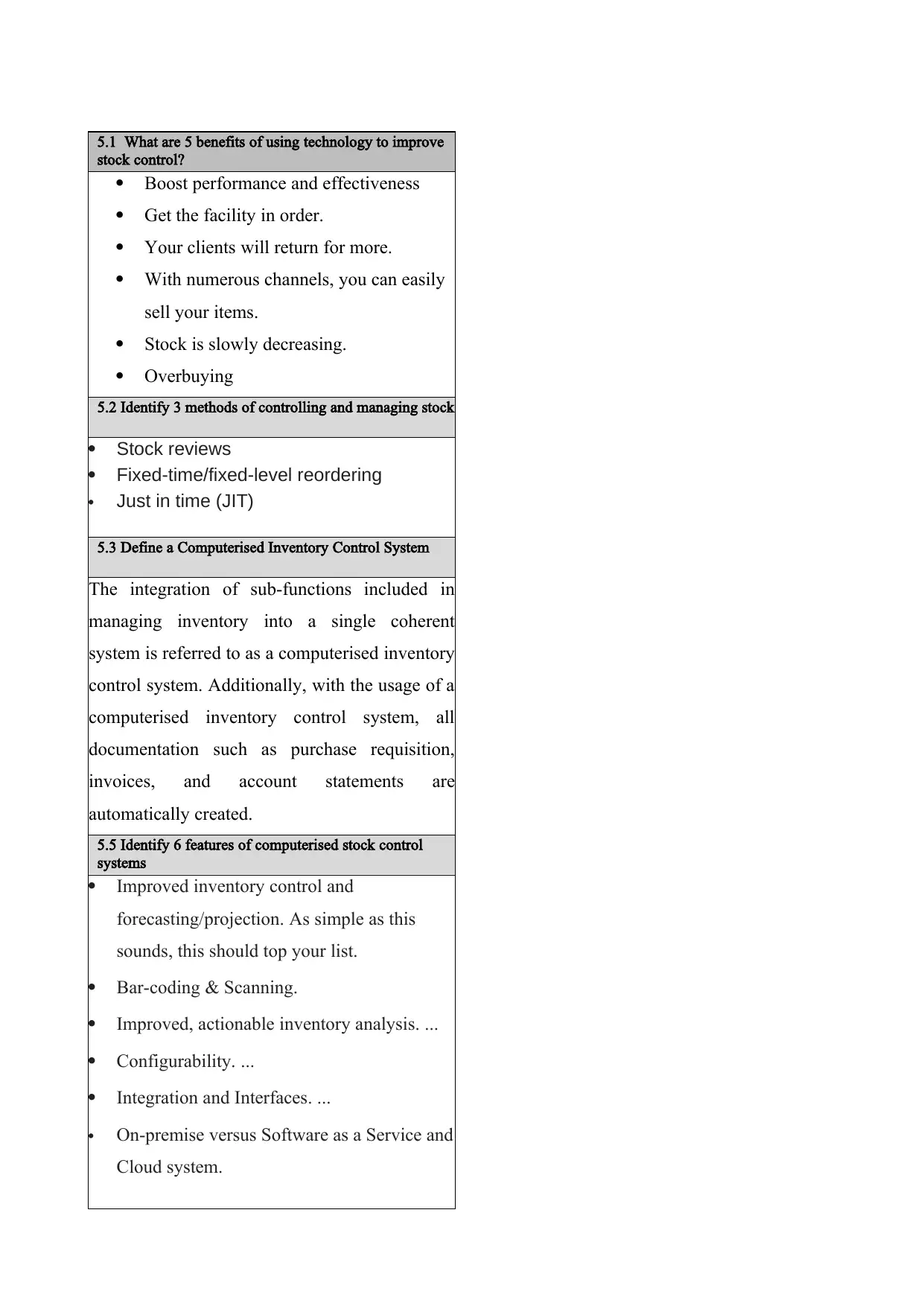
5.1 What are 5 benefits of using technology to improve
stock control?
Boost performance and effectiveness
Get the facility in order.
Your clients will return for more.
With numerous channels, you can easily
sell your items.
Stock is slowly decreasing.
Overbuying
5.2 Identify 3 methods of controlling and managing stock
Stock reviews
Fixed-time/fixed-level reordering
Just in time (JIT)
5.3 Define a Computerised Inventory Control System
The integration of sub-functions included in
managing inventory into a single coherent
system is referred to as a computerised inventory
control system. Additionally, with the usage of a
computerised inventory control system, all
documentation such as purchase requisition,
invoices, and account statements are
automatically created.
5.5 Identify 6 features of computerised stock control
systems
Improved inventory control and
forecasting/projection. As simple as this
sounds, this should top your list.
Bar-coding & Scanning.
Improved, actionable inventory analysis. ...
Configurability. ...
Integration and Interfaces. ...
On-premise versus Software as a Service and
Cloud system.
stock control?
Boost performance and effectiveness
Get the facility in order.
Your clients will return for more.
With numerous channels, you can easily
sell your items.
Stock is slowly decreasing.
Overbuying
5.2 Identify 3 methods of controlling and managing stock
Stock reviews
Fixed-time/fixed-level reordering
Just in time (JIT)
5.3 Define a Computerised Inventory Control System
The integration of sub-functions included in
managing inventory into a single coherent
system is referred to as a computerised inventory
control system. Additionally, with the usage of a
computerised inventory control system, all
documentation such as purchase requisition,
invoices, and account statements are
automatically created.
5.5 Identify 6 features of computerised stock control
systems
Improved inventory control and
forecasting/projection. As simple as this
sounds, this should top your list.
Bar-coding & Scanning.
Improved, actionable inventory analysis. ...
Configurability. ...
Integration and Interfaces. ...
On-premise versus Software as a Service and
Cloud system.
Paraphrase This Document
Need a fresh take? Get an instant paraphrase of this document with our AI Paraphraser
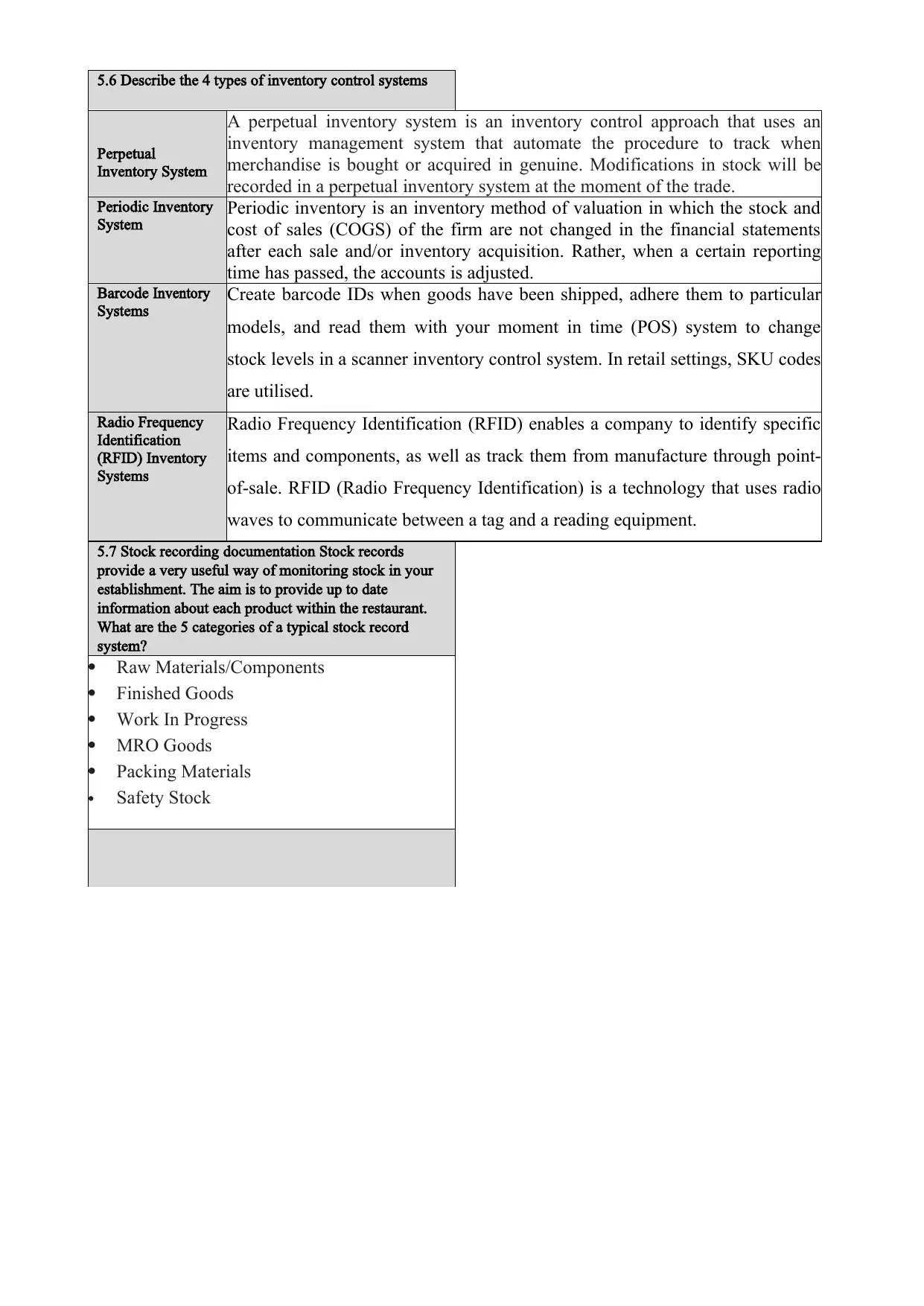
5.6 Describe the 4 types of inventory control systems
Perpetual
Inventory System
A perpetual inventory system is an inventory control approach that uses an
inventory management system that automate the procedure to track when
merchandise is bought or acquired in genuine. Modifications in stock will be
recorded in a perpetual inventory system at the moment of the trade.
Periodic Inventory
System Periodic inventory is an inventory method of valuation in which the stock and
cost of sales (COGS) of the firm are not changed in the financial statements
after each sale and/or inventory acquisition. Rather, when a certain reporting
time has passed, the accounts is adjusted.
Barcode Inventory
Systems Create barcode IDs when goods have been shipped, adhere them to particular
models, and read them with your moment in time (POS) system to change
stock levels in a scanner inventory control system. In retail settings, SKU codes
are utilised.
Radio Frequency
Identification
(RFID) Inventory
Systems
Radio Frequency Identification (RFID) enables a company to identify specific
items and components, as well as track them from manufacture through point-
of-sale. RFID (Radio Frequency Identification) is a technology that uses radio
waves to communicate between a tag and a reading equipment.
5.7 Stock recording documentation Stock records
provide a very useful way of monitoring stock in your
establishment. The aim is to provide up to date
information about each product within the restaurant.
What are the 5 categories of a typical stock record
system?
Raw Materials/Components
Finished Goods
Work In Progress
MRO Goods
Packing Materials
Safety Stock
Perpetual
Inventory System
A perpetual inventory system is an inventory control approach that uses an
inventory management system that automate the procedure to track when
merchandise is bought or acquired in genuine. Modifications in stock will be
recorded in a perpetual inventory system at the moment of the trade.
Periodic Inventory
System Periodic inventory is an inventory method of valuation in which the stock and
cost of sales (COGS) of the firm are not changed in the financial statements
after each sale and/or inventory acquisition. Rather, when a certain reporting
time has passed, the accounts is adjusted.
Barcode Inventory
Systems Create barcode IDs when goods have been shipped, adhere them to particular
models, and read them with your moment in time (POS) system to change
stock levels in a scanner inventory control system. In retail settings, SKU codes
are utilised.
Radio Frequency
Identification
(RFID) Inventory
Systems
Radio Frequency Identification (RFID) enables a company to identify specific
items and components, as well as track them from manufacture through point-
of-sale. RFID (Radio Frequency Identification) is a technology that uses radio
waves to communicate between a tag and a reading equipment.
5.7 Stock recording documentation Stock records
provide a very useful way of monitoring stock in your
establishment. The aim is to provide up to date
information about each product within the restaurant.
What are the 5 categories of a typical stock record
system?
Raw Materials/Components
Finished Goods
Work In Progress
MRO Goods
Packing Materials
Safety Stock
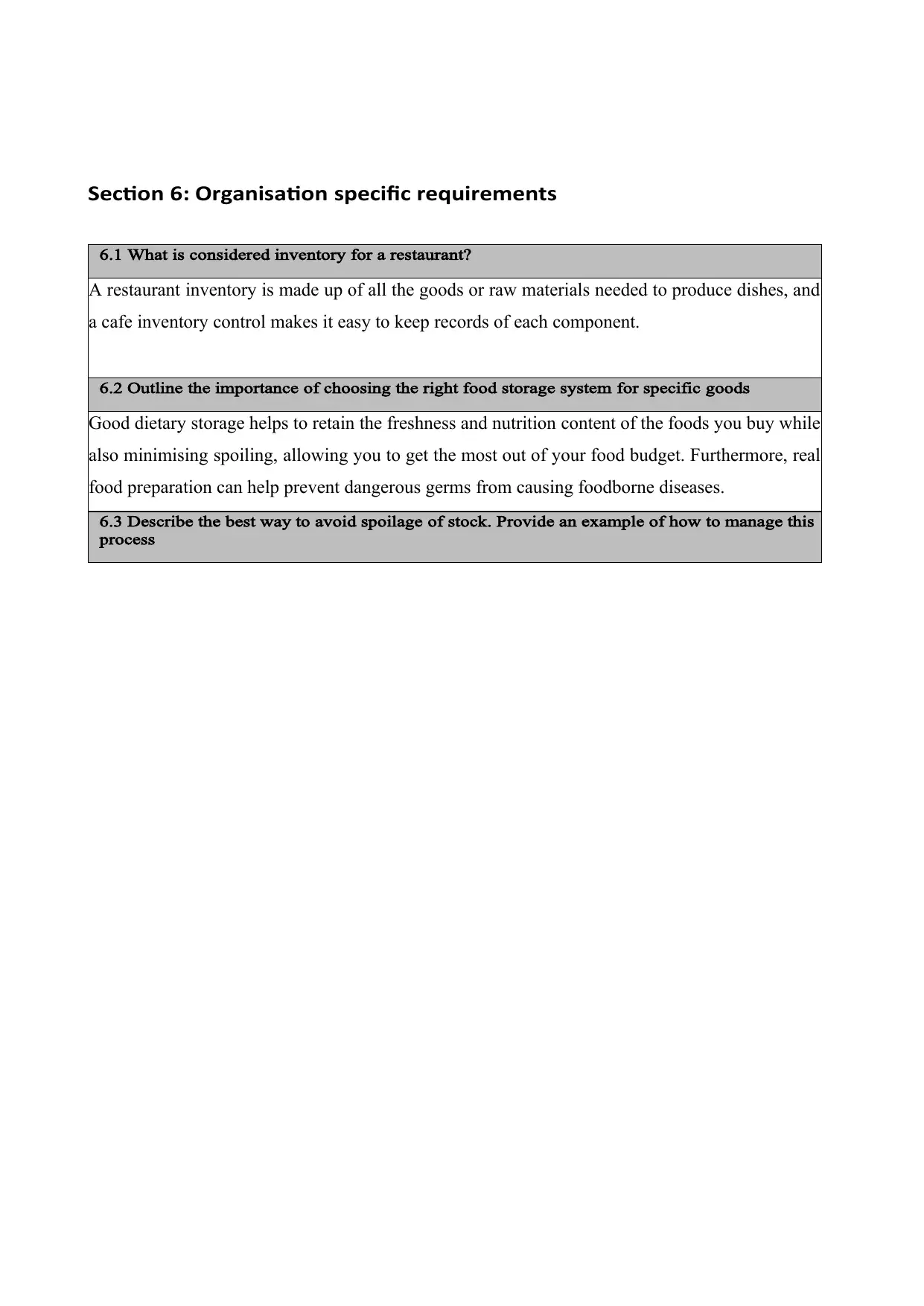
Section 6: Organisation specific requirements
6.1 What is considered inventory for a restaurant?
A restaurant inventory is made up of all the goods or raw materials needed to produce dishes, and
a cafe inventory control makes it easy to keep records of each component.
6.2 Outline the importance of choosing the right food storage system for specific goods
Good dietary storage helps to retain the freshness and nutrition content of the foods you buy while
also minimising spoiling, allowing you to get the most out of your food budget. Furthermore, real
food preparation can help prevent dangerous germs from causing foodborne diseases.
6.3 Describe the best way to avoid spoilage of stock. Provide an example of how to manage this
process
6.1 What is considered inventory for a restaurant?
A restaurant inventory is made up of all the goods or raw materials needed to produce dishes, and
a cafe inventory control makes it easy to keep records of each component.
6.2 Outline the importance of choosing the right food storage system for specific goods
Good dietary storage helps to retain the freshness and nutrition content of the foods you buy while
also minimising spoiling, allowing you to get the most out of your food budget. Furthermore, real
food preparation can help prevent dangerous germs from causing foodborne diseases.
6.3 Describe the best way to avoid spoilage of stock. Provide an example of how to manage this
process
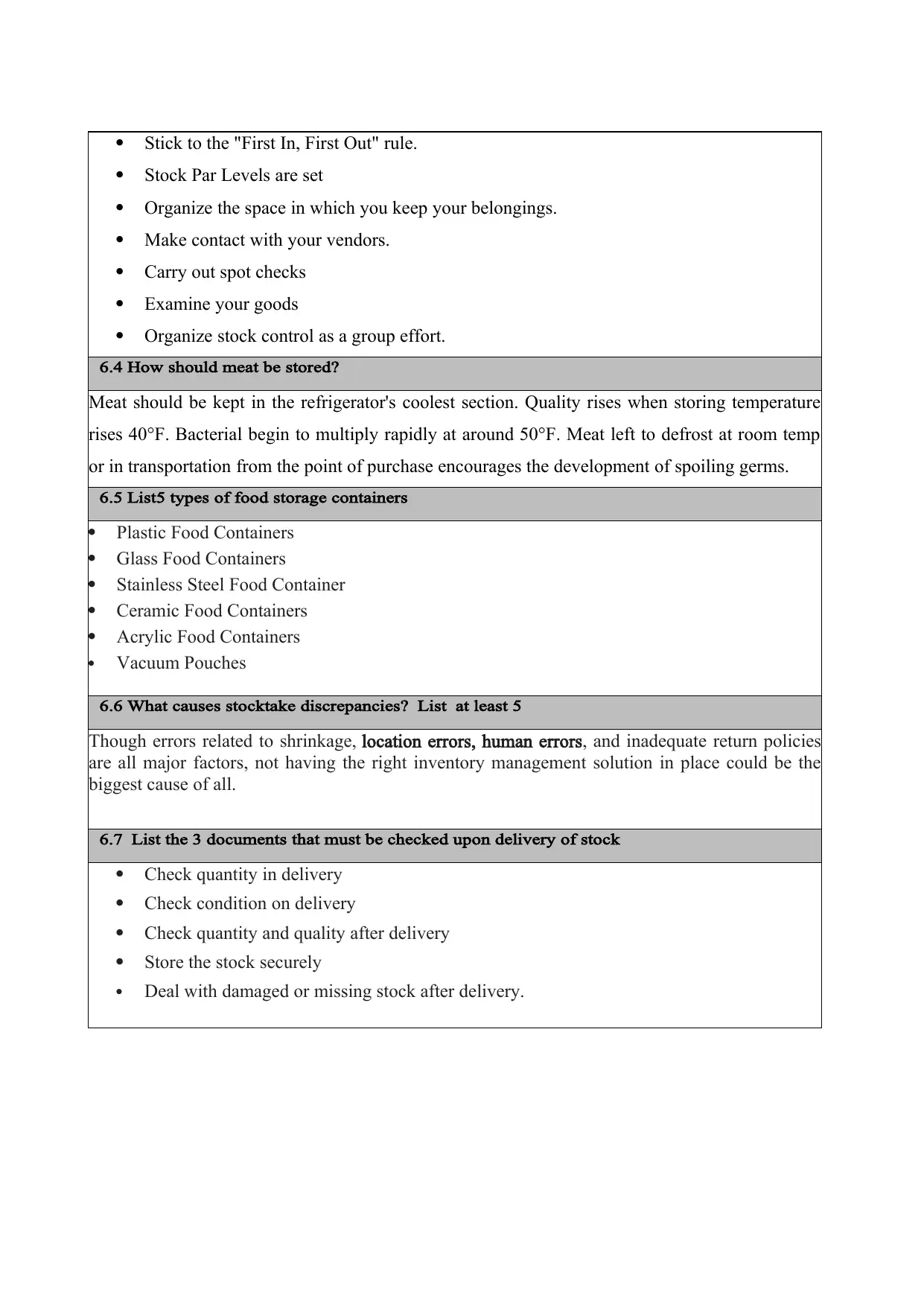
Stick to the "First In, First Out" rule.
Stock Par Levels are set
Organize the space in which you keep your belongings.
Make contact with your vendors.
Carry out spot checks
Examine your goods
Organize stock control as a group effort.
6.4 How should meat be stored?
Meat should be kept in the refrigerator's coolest section. Quality rises when storing temperature
rises 40°F. Bacterial begin to multiply rapidly at around 50°F. Meat left to defrost at room temp
or in transportation from the point of purchase encourages the development of spoiling germs.
6.5 List5 types of food storage containers
Plastic Food Containers
Glass Food Containers
Stainless Steel Food Container
Ceramic Food Containers
Acrylic Food Containers
Vacuum Pouches
6.6 What causes stocktake discrepancies? List at least 5
Though errors related to shrinkage, location errors, human errors, and inadequate return policies
are all major factors, not having the right inventory management solution in place could be the
biggest cause of all.
6.7 List the 3 documents that must be checked upon delivery of stock
Check quantity in delivery
Check condition on delivery
Check quantity and quality after delivery
Store the stock securely
Deal with damaged or missing stock after delivery.
Stock Par Levels are set
Organize the space in which you keep your belongings.
Make contact with your vendors.
Carry out spot checks
Examine your goods
Organize stock control as a group effort.
6.4 How should meat be stored?
Meat should be kept in the refrigerator's coolest section. Quality rises when storing temperature
rises 40°F. Bacterial begin to multiply rapidly at around 50°F. Meat left to defrost at room temp
or in transportation from the point of purchase encourages the development of spoiling germs.
6.5 List5 types of food storage containers
Plastic Food Containers
Glass Food Containers
Stainless Steel Food Container
Ceramic Food Containers
Acrylic Food Containers
Vacuum Pouches
6.6 What causes stocktake discrepancies? List at least 5
Though errors related to shrinkage, location errors, human errors, and inadequate return policies
are all major factors, not having the right inventory management solution in place could be the
biggest cause of all.
6.7 List the 3 documents that must be checked upon delivery of stock
Check quantity in delivery
Check condition on delivery
Check quantity and quality after delivery
Store the stock securely
Deal with damaged or missing stock after delivery.
Secure Best Marks with AI Grader
Need help grading? Try our AI Grader for instant feedback on your assignments.
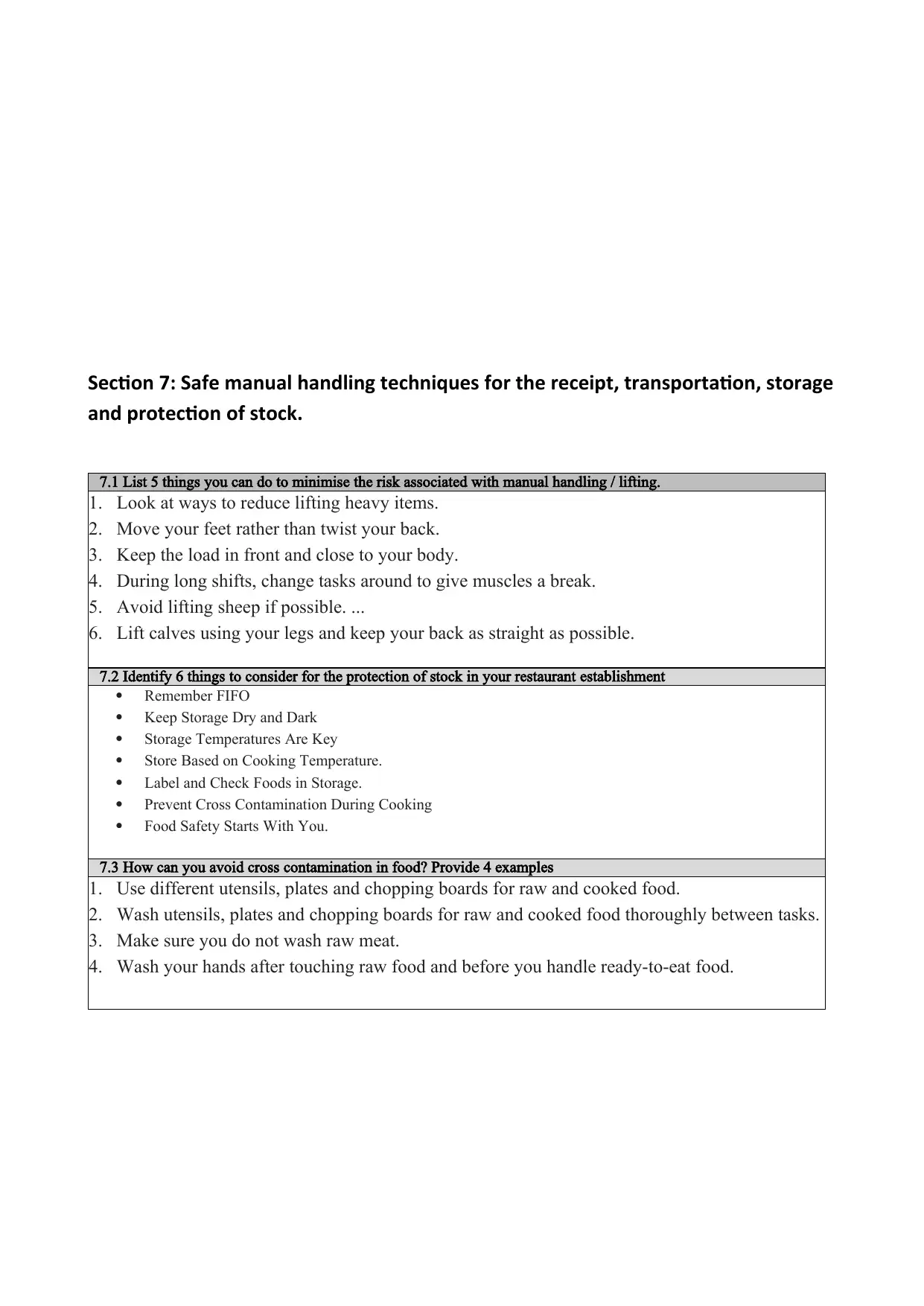
Section 7: Safe manual handling techniques for the receipt, transportation, storage
and protection of stock.
7.1 List 5 things you can do to minimise the risk associated with manual handling / lifting.
1. Look at ways to reduce lifting heavy items.
2. Move your feet rather than twist your back.
3. Keep the load in front and close to your body.
4. During long shifts, change tasks around to give muscles a break.
5. Avoid lifting sheep if possible. ...
6. Lift calves using your legs and keep your back as straight as possible.
7.2 Identify 6 things to consider for the protection of stock in your restaurant establishment
Remember FIFO
Keep Storage Dry and Dark
Storage Temperatures Are Key
Store Based on Cooking Temperature.
Label and Check Foods in Storage.
Prevent Cross Contamination During Cooking
Food Safety Starts With You.
7.3 How can you avoid cross contamination in food? Provide 4 examples
1. Use different utensils, plates and chopping boards for raw and cooked food.
2. Wash utensils, plates and chopping boards for raw and cooked food thoroughly between tasks.
3. Make sure you do not wash raw meat.
4. Wash your hands after touching raw food and before you handle ready-to-eat food.
and protection of stock.
7.1 List 5 things you can do to minimise the risk associated with manual handling / lifting.
1. Look at ways to reduce lifting heavy items.
2. Move your feet rather than twist your back.
3. Keep the load in front and close to your body.
4. During long shifts, change tasks around to give muscles a break.
5. Avoid lifting sheep if possible. ...
6. Lift calves using your legs and keep your back as straight as possible.
7.2 Identify 6 things to consider for the protection of stock in your restaurant establishment
Remember FIFO
Keep Storage Dry and Dark
Storage Temperatures Are Key
Store Based on Cooking Temperature.
Label and Check Foods in Storage.
Prevent Cross Contamination During Cooking
Food Safety Starts With You.
7.3 How can you avoid cross contamination in food? Provide 4 examples
1. Use different utensils, plates and chopping boards for raw and cooked food.
2. Wash utensils, plates and chopping boards for raw and cooked food thoroughly between tasks.
3. Make sure you do not wash raw meat.
4. Wash your hands after touching raw food and before you handle ready-to-eat food.
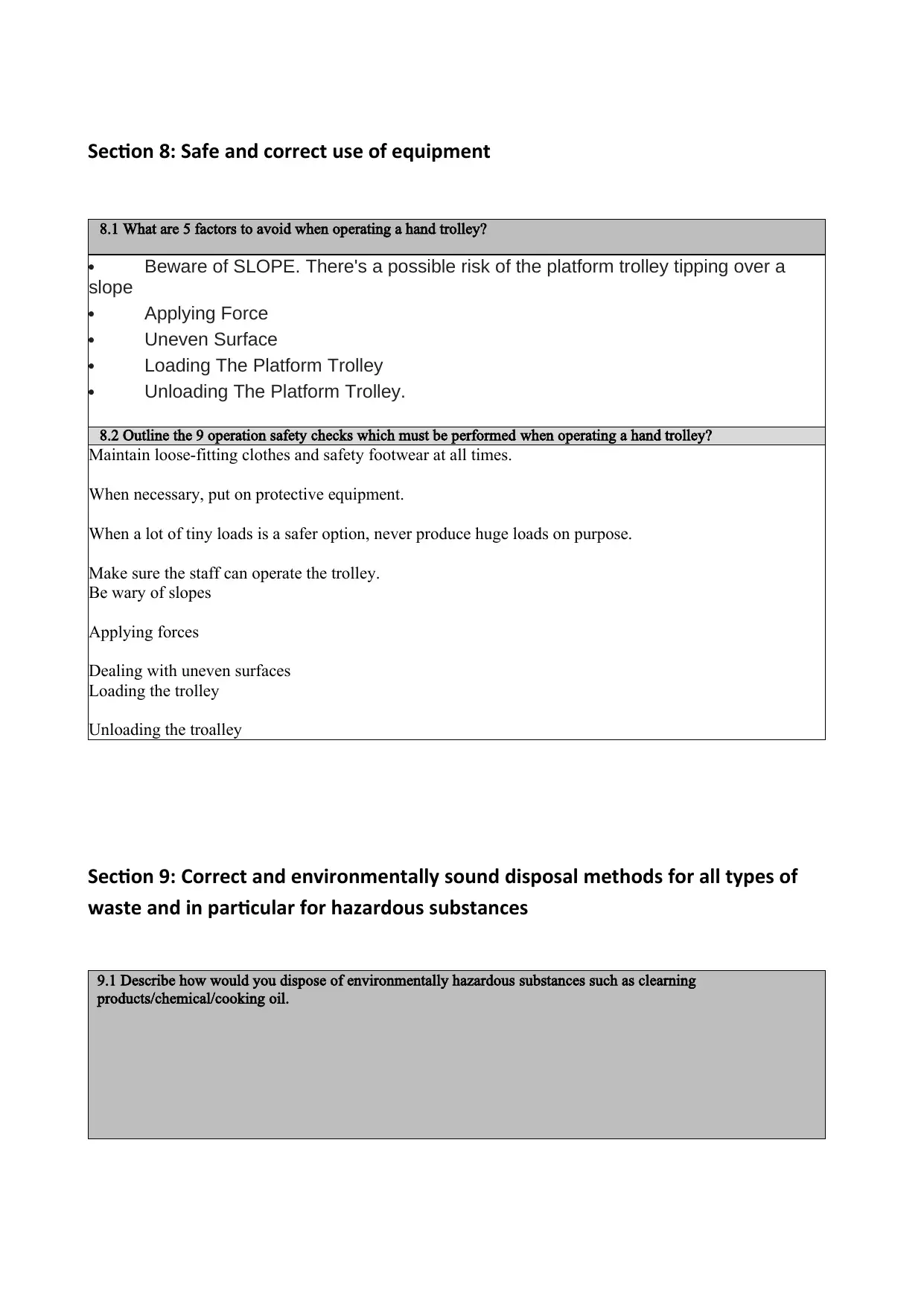
Section 8: Safe and correct use of equipment
8.1 What are 5 factors to avoid when operating a hand trolley?
Beware of SLOPE. There's a possible risk of the platform trolley tipping over a
slope
Applying Force
Uneven Surface
Loading The Platform Trolley
Unloading The Platform Trolley.
8.2 Outline the 9 operation safety checks which must be performed when operating a hand trolley?
Maintain loose-fitting clothes and safety footwear at all times.
When necessary, put on protective equipment.
When a lot of tiny loads is a safer option, never produce huge loads on purpose.
Make sure the staff can operate the trolley.
Be wary of slopes
Applying forces
Dealing with uneven surfaces
Loading the trolley
Unloading the troalley
Section 9: Correct and environmentally sound disposal methods for all types of
waste and in particular for hazardous substances
9.1 Describe how would you dispose of environmentally hazardous substances such as clearning
products/chemical/cooking oil.
8.1 What are 5 factors to avoid when operating a hand trolley?
Beware of SLOPE. There's a possible risk of the platform trolley tipping over a
slope
Applying Force
Uneven Surface
Loading The Platform Trolley
Unloading The Platform Trolley.
8.2 Outline the 9 operation safety checks which must be performed when operating a hand trolley?
Maintain loose-fitting clothes and safety footwear at all times.
When necessary, put on protective equipment.
When a lot of tiny loads is a safer option, never produce huge loads on purpose.
Make sure the staff can operate the trolley.
Be wary of slopes
Applying forces
Dealing with uneven surfaces
Loading the trolley
Unloading the troalley
Section 9: Correct and environmentally sound disposal methods for all types of
waste and in particular for hazardous substances
9.1 Describe how would you dispose of environmentally hazardous substances such as clearning
products/chemical/cooking oil.
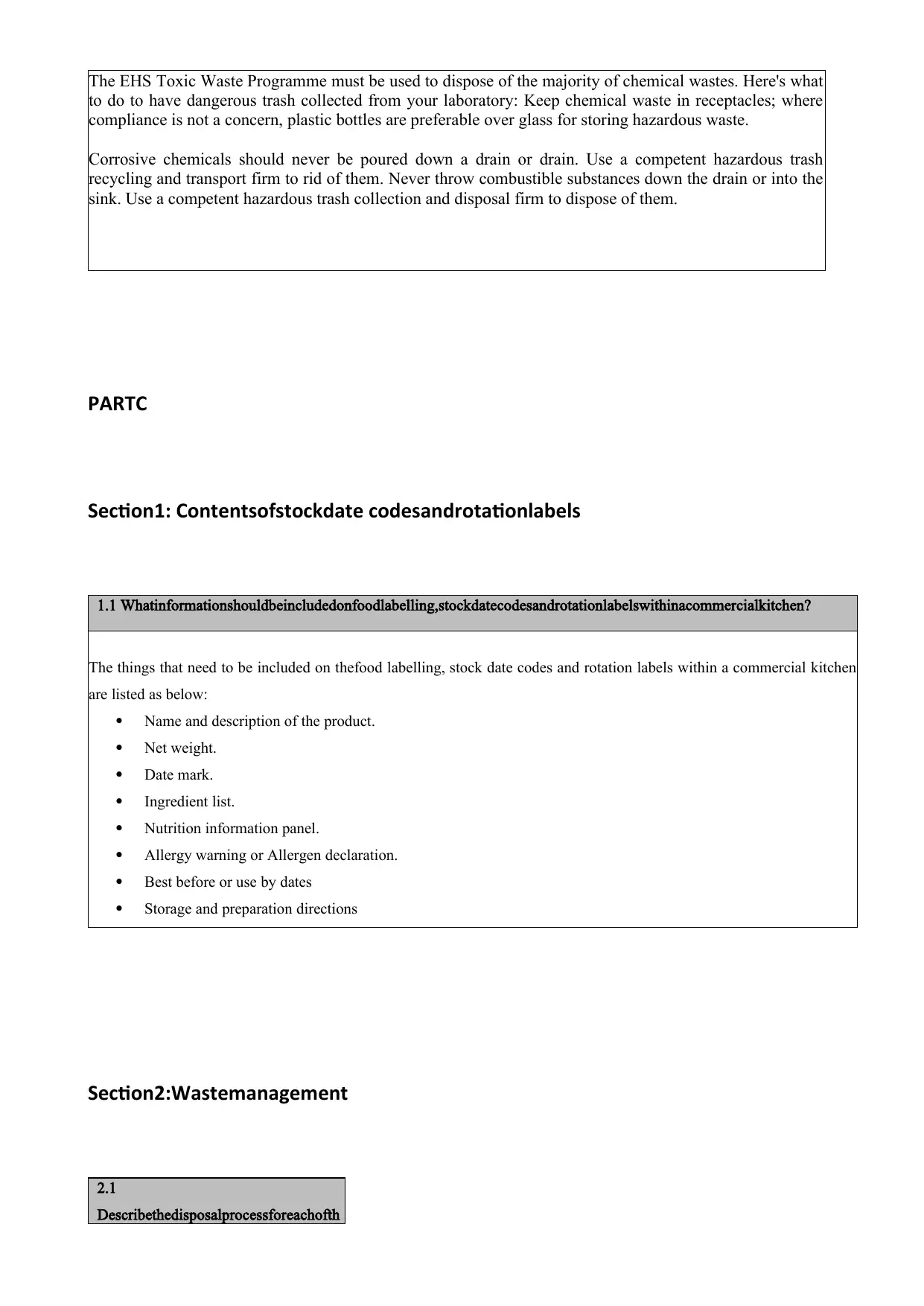
The EHS Toxic Waste Programme must be used to dispose of the majority of chemical wastes. Here's what
to do to have dangerous trash collected from your laboratory: Keep chemical waste in receptacles; where
compliance is not a concern, plastic bottles are preferable over glass for storing hazardous waste.
Corrosive chemicals should never be poured down a drain or drain. Use a competent hazardous trash
recycling and transport firm to rid of them. Never throw combustible substances down the drain or into the
sink. Use a competent hazardous trash collection and disposal firm to dispose of them.
PARTC
Section1: Contentsofstockdate codesandrotationlabels
1.1 Whatinformationshouldbeincludedonfoodlabelling,stockdatecodesandrotationlabelswithinacommercialkitchen?
The things that need to be included on thefood labelling, stock date codes and rotation labels within a commercial kitchen
are listed as below:
Name and description of the product.
Net weight.
Date mark.
Ingredient list.
Nutrition information panel.
Allergy warning or Allergen declaration.
Best before or use by dates
Storage and preparation directions
Section2:Wastemanagement
2.1
Describethedisposalprocessforeachofth
to do to have dangerous trash collected from your laboratory: Keep chemical waste in receptacles; where
compliance is not a concern, plastic bottles are preferable over glass for storing hazardous waste.
Corrosive chemicals should never be poured down a drain or drain. Use a competent hazardous trash
recycling and transport firm to rid of them. Never throw combustible substances down the drain or into the
sink. Use a competent hazardous trash collection and disposal firm to dispose of them.
PARTC
Section1: Contentsofstockdate codesandrotationlabels
1.1 Whatinformationshouldbeincludedonfoodlabelling,stockdatecodesandrotationlabelswithinacommercialkitchen?
The things that need to be included on thefood labelling, stock date codes and rotation labels within a commercial kitchen
are listed as below:
Name and description of the product.
Net weight.
Date mark.
Ingredient list.
Nutrition information panel.
Allergy warning or Allergen declaration.
Best before or use by dates
Storage and preparation directions
Section2:Wastemanagement
2.1
Describethedisposalprocessforeachofth
Paraphrase This Document
Need a fresh take? Get an instant paraphrase of this document with our AI Paraphraser
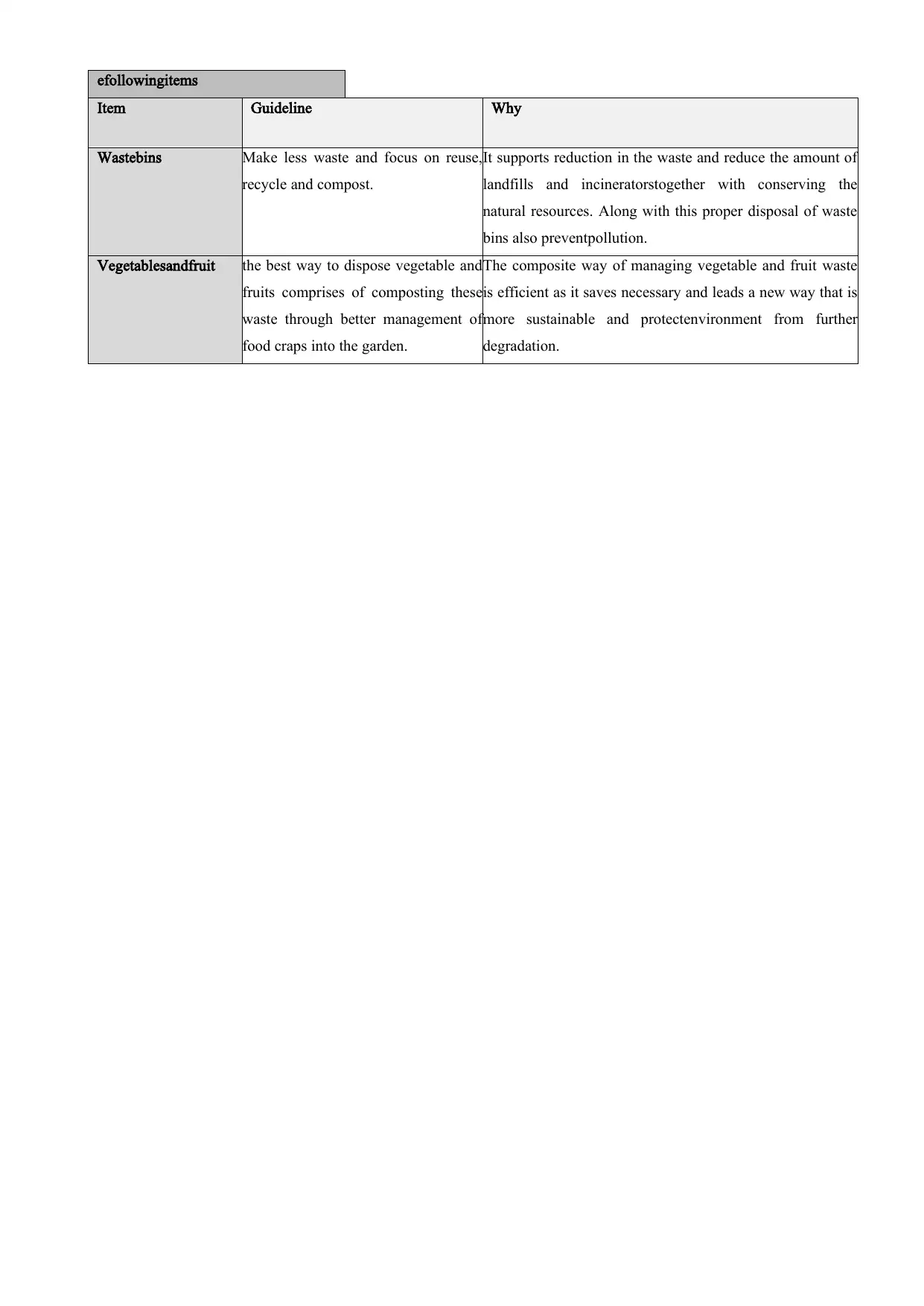
efollowingitems
Item Guideline Why
Wastebins Make less waste and focus on reuse,
recycle and compost.
It supports reduction in the waste and reduce the amount of
landfills and incineratorstogether with conserving the
natural resources. Along with this proper disposal of waste
bins also preventpollution.
Vegetablesandfruit the best way to dispose vegetable and
fruits comprises of composting these
waste through better management of
food craps into the garden.
The composite way of managing vegetable and fruit waste
is efficient as it saves necessary and leads a new way that is
more sustainable and protectenvironment from further
degradation.
Item Guideline Why
Wastebins Make less waste and focus on reuse,
recycle and compost.
It supports reduction in the waste and reduce the amount of
landfills and incineratorstogether with conserving the
natural resources. Along with this proper disposal of waste
bins also preventpollution.
Vegetablesandfruit the best way to dispose vegetable and
fruits comprises of composting these
waste through better management of
food craps into the garden.
The composite way of managing vegetable and fruit waste
is efficient as it saves necessary and leads a new way that is
more sustainable and protectenvironment from further
degradation.
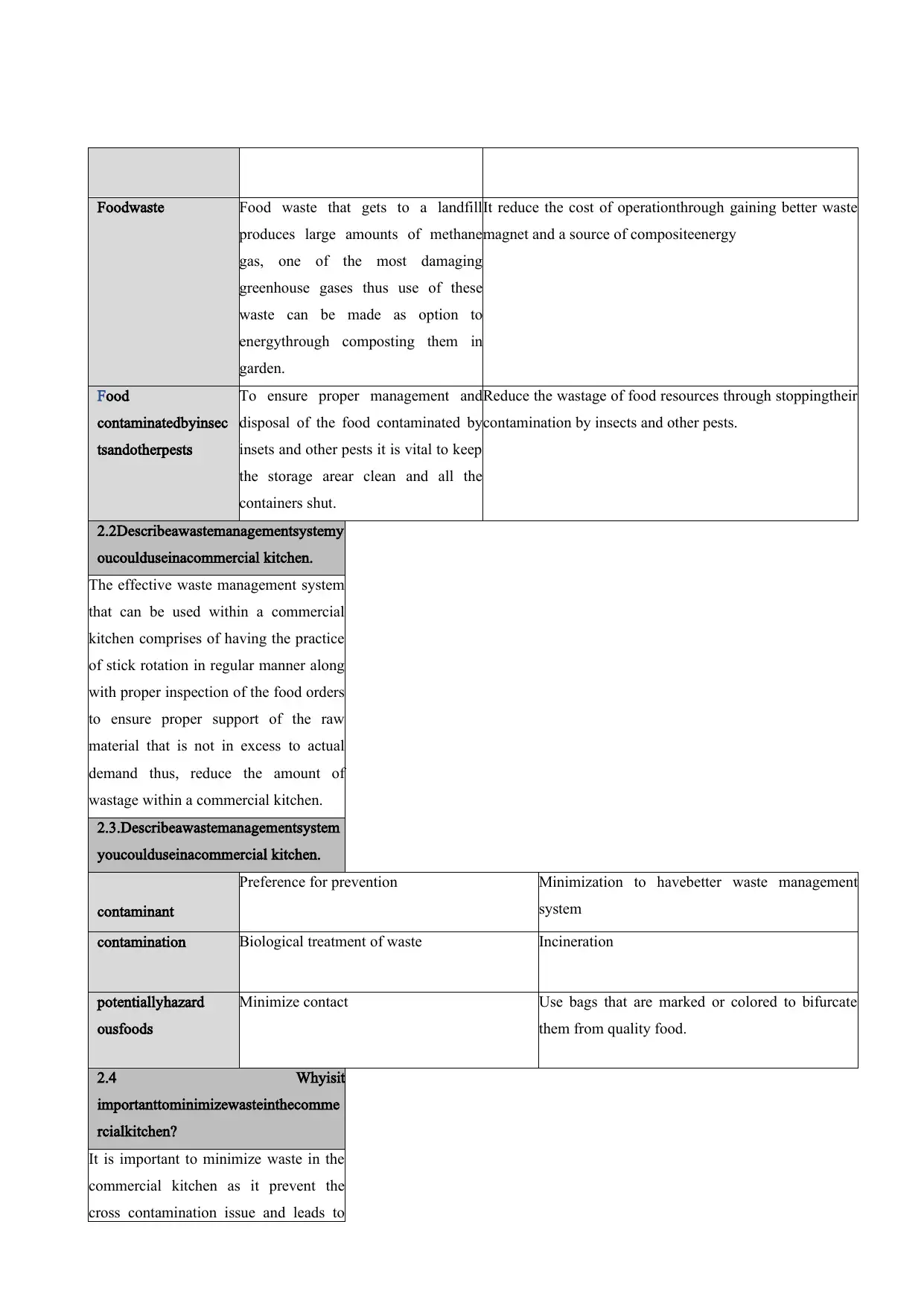
Foodwaste Food waste that gets to a landfill
produces large amounts of methane
gas, one of the most damaging
greenhouse gases thus use of these
waste can be made as option to
energythrough composting them in
garden.
It reduce the cost of operationthrough gaining better waste
magnet and a source of compositeenergy
Food
contaminatedbyinsec
tsandotherpests
To ensure proper management and
disposal of the food contaminated by
insets and other pests it is vital to keep
the storage arear clean and all the
containers shut.
Reduce the wastage of food resources through stoppingtheir
contamination by insects and other pests.
2.2Describeawastemanagementsystemy
oucoulduseinacommercial kitchen.
The effective waste management system
that can be used within a commercial
kitchen comprises of having the practice
of stick rotation in regular manner along
with proper inspection of the food orders
to ensure proper support of the raw
material that is not in excess to actual
demand thus, reduce the amount of
wastage within a commercial kitchen.
2.3.Describeawastemanagementsystem
youcoulduseinacommercial kitchen.
contaminant
Preference for prevention Minimization to havebetter waste management
system
contamination Biological treatment of waste Incineration
potentiallyhazard
ousfoods
Minimize contact Use bags that are marked or colored to bifurcate
them from quality food.
2.4 Whyisit
importanttominimizewasteinthecomme
rcialkitchen?
It is important to minimize waste in the
commercial kitchen as it prevent the
cross contamination issue and leads to
produces large amounts of methane
gas, one of the most damaging
greenhouse gases thus use of these
waste can be made as option to
energythrough composting them in
garden.
It reduce the cost of operationthrough gaining better waste
magnet and a source of compositeenergy
Food
contaminatedbyinsec
tsandotherpests
To ensure proper management and
disposal of the food contaminated by
insets and other pests it is vital to keep
the storage arear clean and all the
containers shut.
Reduce the wastage of food resources through stoppingtheir
contamination by insects and other pests.
2.2Describeawastemanagementsystemy
oucoulduseinacommercial kitchen.
The effective waste management system
that can be used within a commercial
kitchen comprises of having the practice
of stick rotation in regular manner along
with proper inspection of the food orders
to ensure proper support of the raw
material that is not in excess to actual
demand thus, reduce the amount of
wastage within a commercial kitchen.
2.3.Describeawastemanagementsystem
youcoulduseinacommercial kitchen.
contaminant
Preference for prevention Minimization to havebetter waste management
system
contamination Biological treatment of waste Incineration
potentiallyhazard
ousfoods
Minimize contact Use bags that are marked or colored to bifurcate
them from quality food.
2.4 Whyisit
importanttominimizewasteinthecomme
rcialkitchen?
It is important to minimize waste in the
commercial kitchen as it prevent the
cross contamination issue and leads to
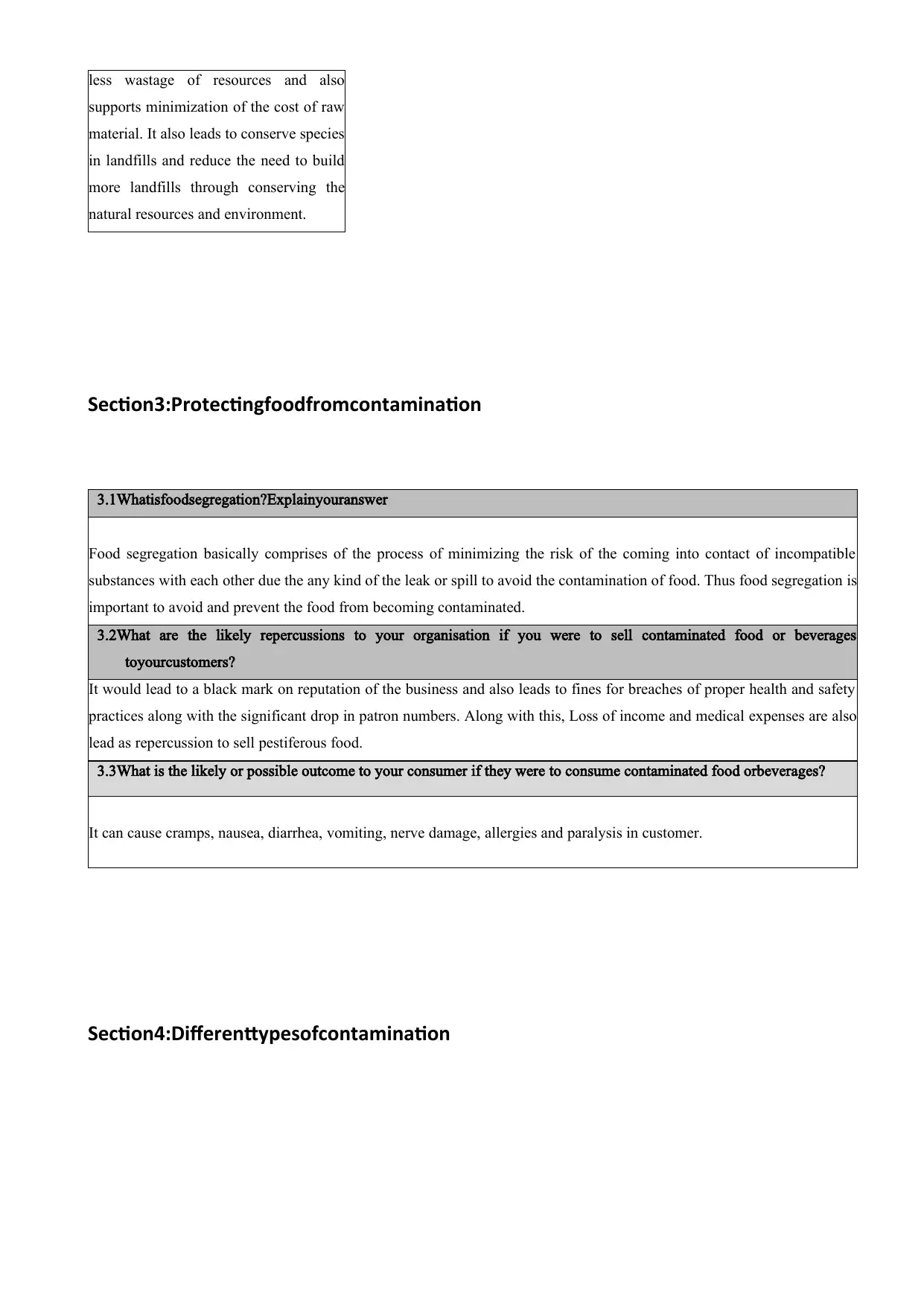
less wastage of resources and also
supports minimization of the cost of raw
material. It also leads to conserve species
in landfills and reduce the need to build
more landfills through conserving the
natural resources and environment.
Section3:Protectingfoodfromcontamination
3.1Whatisfoodsegregation?Explainyouranswer
Food segregation basically comprises of the process of minimizing the risk of the coming into contact of incompatible
substances with each other due the any kind of the leak or spill to avoid the contamination of food. Thus food segregation is
important to avoid and prevent the food from becoming contaminated.
3.2What are the likely repercussions to your organisation if you were to sell contaminated food or beverages
toyourcustomers?
It would lead to a black mark on reputation of the business and also leads to fines for breaches of proper health and safety
practices along with the significant drop in patron numbers. Along with this, Loss of income and medical expenses are also
lead as repercussion to sell pestiferous food.
3.3What is the likely or possible outcome to your consumer if they were to consume contaminated food orbeverages?
It can cause cramps, nausea, diarrhea, vomiting, nerve damage, allergies and paralysis in customer.
Section4:Differenttypesofcontamination
supports minimization of the cost of raw
material. It also leads to conserve species
in landfills and reduce the need to build
more landfills through conserving the
natural resources and environment.
Section3:Protectingfoodfromcontamination
3.1Whatisfoodsegregation?Explainyouranswer
Food segregation basically comprises of the process of minimizing the risk of the coming into contact of incompatible
substances with each other due the any kind of the leak or spill to avoid the contamination of food. Thus food segregation is
important to avoid and prevent the food from becoming contaminated.
3.2What are the likely repercussions to your organisation if you were to sell contaminated food or beverages
toyourcustomers?
It would lead to a black mark on reputation of the business and also leads to fines for breaches of proper health and safety
practices along with the significant drop in patron numbers. Along with this, Loss of income and medical expenses are also
lead as repercussion to sell pestiferous food.
3.3What is the likely or possible outcome to your consumer if they were to consume contaminated food orbeverages?
It can cause cramps, nausea, diarrhea, vomiting, nerve damage, allergies and paralysis in customer.
Section4:Differenttypesofcontamination
Secure Best Marks with AI Grader
Need help grading? Try our AI Grader for instant feedback on your assignments.
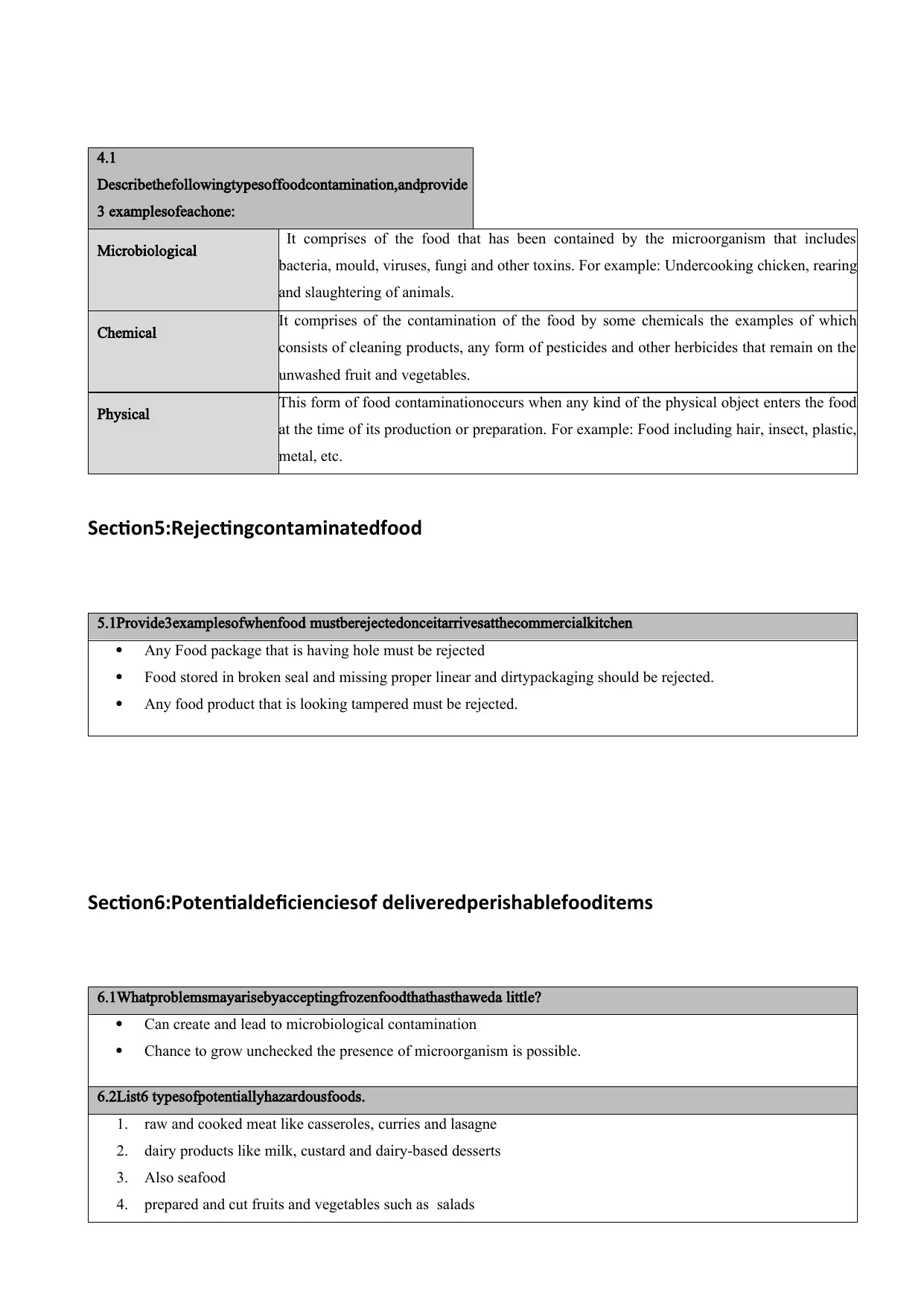
4.1
Describethefollowingtypesoffoodcontamination,andprovide
3 examplesofeachone:
Microbiological It comprises of the food that has been contained by the microorganism that includes
bacteria, mould, viruses, fungi and other toxins. For example: Undercooking chicken, rearing
and slaughtering of animals.
Chemical It comprises of the contamination of the food by some chemicals the examples of which
consists of cleaning products, any form of pesticides and other herbicides that remain on the
unwashed fruit and vegetables.
Physical This form of food contaminationoccurs when any kind of the physical object enters the food
at the time of its production or preparation. For example: Food including hair, insect, plastic,
metal, etc.
Section5:Rejectingcontaminatedfood
5.1Provide3examplesofwhenfood mustberejectedonceitarrivesatthecommercialkitchen
Any Food package that is having hole must be rejected
Food stored in broken seal and missing proper linear and dirtypackaging should be rejected.
Any food product that is looking tampered must be rejected.
Section6:Potentialdeficienciesof deliveredperishablefooditems
6.1Whatproblemsmayarisebyacceptingfrozenfoodthathasthaweda little?
Can create and lead to microbiological contamination
Chance to grow unchecked the presence of microorganism is possible.
6.2List6 typesofpotentiallyhazardousfoods.
1. raw and cooked meat like casseroles, curries and lasagne
2. dairy products like milk, custard and dairy‐based desserts
3. Also seafood
4. prepared and cut fruits and vegetables such as salads
Describethefollowingtypesoffoodcontamination,andprovide
3 examplesofeachone:
Microbiological It comprises of the food that has been contained by the microorganism that includes
bacteria, mould, viruses, fungi and other toxins. For example: Undercooking chicken, rearing
and slaughtering of animals.
Chemical It comprises of the contamination of the food by some chemicals the examples of which
consists of cleaning products, any form of pesticides and other herbicides that remain on the
unwashed fruit and vegetables.
Physical This form of food contaminationoccurs when any kind of the physical object enters the food
at the time of its production or preparation. For example: Food including hair, insect, plastic,
metal, etc.
Section5:Rejectingcontaminatedfood
5.1Provide3examplesofwhenfood mustberejectedonceitarrivesatthecommercialkitchen
Any Food package that is having hole must be rejected
Food stored in broken seal and missing proper linear and dirtypackaging should be rejected.
Any food product that is looking tampered must be rejected.
Section6:Potentialdeficienciesof deliveredperishablefooditems
6.1Whatproblemsmayarisebyacceptingfrozenfoodthathasthaweda little?
Can create and lead to microbiological contamination
Chance to grow unchecked the presence of microorganism is possible.
6.2List6 typesofpotentiallyhazardousfoods.
1. raw and cooked meat like casseroles, curries and lasagne
2. dairy products like milk, custard and dairy‐based desserts
3. Also seafood
4. prepared and cut fruits and vegetables such as salads
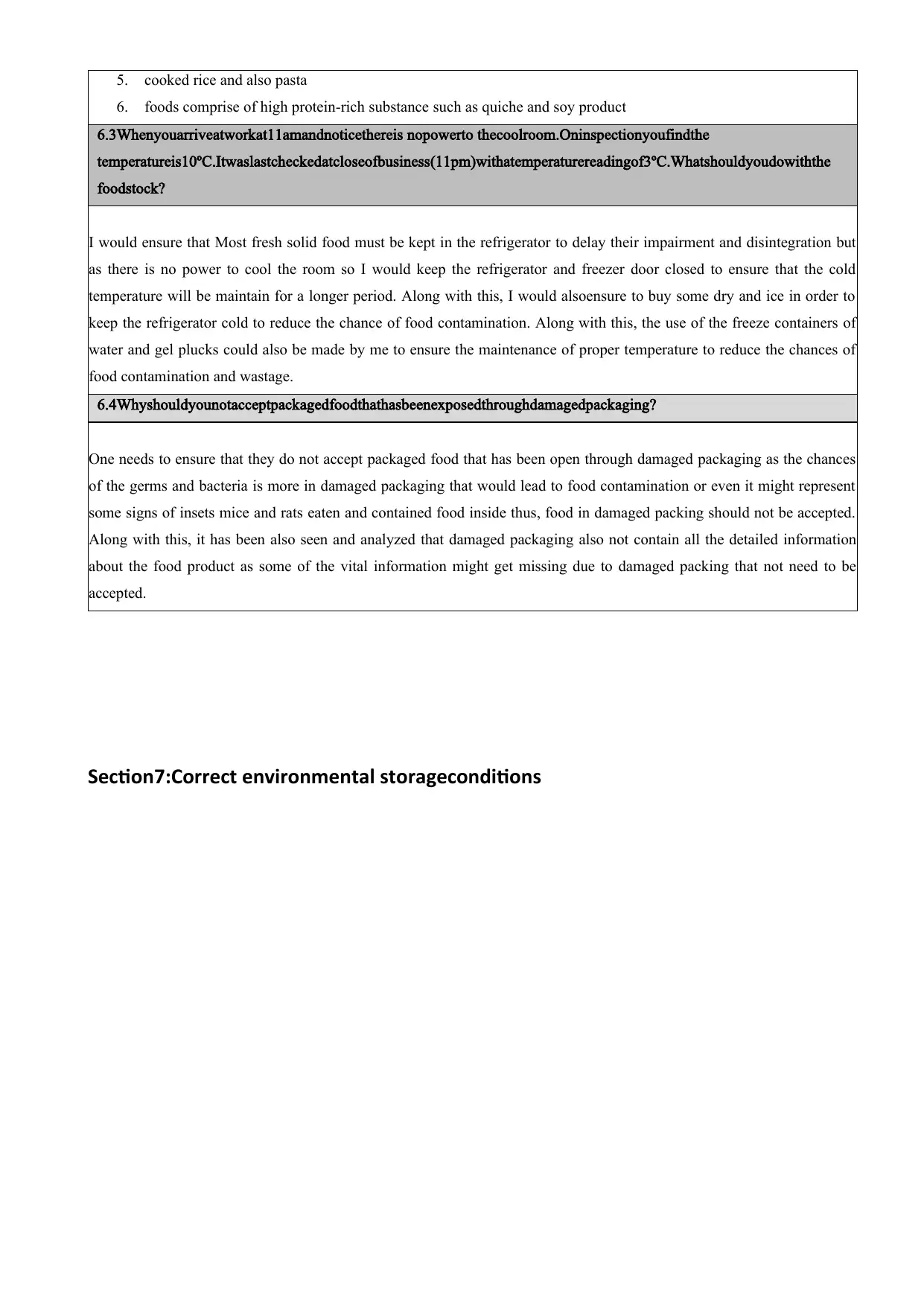
5. cooked rice and also pasta
6. foods comprise of high protein‐rich substance such as quiche and soy product
6.3Whenyouarriveatworkat11amandnoticethereis nopowerto thecoolroom.Oninspectionyoufindthe
temperatureis10ºC.Itwaslastcheckedatcloseofbusiness(11pm)withatemperaturereadingof3ºC.Whatshouldyoudowiththe
foodstock?
I would ensure that Most fresh solid food must be kept in the refrigerator to delay their impairment and disintegration but
as there is no power to cool the room so I would keep the refrigerator and freezer door closed to ensure that the cold
temperature will be maintain for a longer period. Along with this, I would alsoensure to buy some dry and ice in order to
keep the refrigerator cold to reduce the chance of food contamination. Along with this, the use of the freeze containers of
water and gel plucks could also be made by me to ensure the maintenance of proper temperature to reduce the chances of
food contamination and wastage.
6.4Whyshouldyounotacceptpackagedfoodthathasbeenexposedthroughdamagedpackaging?
One needs to ensure that they do not accept packaged food that has been open through damaged packaging as the chances
of the germs and bacteria is more in damaged packaging that would lead to food contamination or even it might represent
some signs of insets mice and rats eaten and contained food inside thus, food in damaged packing should not be accepted.
Along with this, it has been also seen and analyzed that damaged packaging also not contain all the detailed information
about the food product as some of the vital information might get missing due to damaged packing that not need to be
accepted.
Section7:Correct environmental storageconditions
6. foods comprise of high protein‐rich substance such as quiche and soy product
6.3Whenyouarriveatworkat11amandnoticethereis nopowerto thecoolroom.Oninspectionyoufindthe
temperatureis10ºC.Itwaslastcheckedatcloseofbusiness(11pm)withatemperaturereadingof3ºC.Whatshouldyoudowiththe
foodstock?
I would ensure that Most fresh solid food must be kept in the refrigerator to delay their impairment and disintegration but
as there is no power to cool the room so I would keep the refrigerator and freezer door closed to ensure that the cold
temperature will be maintain for a longer period. Along with this, I would alsoensure to buy some dry and ice in order to
keep the refrigerator cold to reduce the chance of food contamination. Along with this, the use of the freeze containers of
water and gel plucks could also be made by me to ensure the maintenance of proper temperature to reduce the chances of
food contamination and wastage.
6.4Whyshouldyounotacceptpackagedfoodthathasbeenexposedthroughdamagedpackaging?
One needs to ensure that they do not accept packaged food that has been open through damaged packaging as the chances
of the germs and bacteria is more in damaged packaging that would lead to food contamination or even it might represent
some signs of insets mice and rats eaten and contained food inside thus, food in damaged packing should not be accepted.
Along with this, it has been also seen and analyzed that damaged packaging also not contain all the detailed information
about the food product as some of the vital information might get missing due to damaged packing that not need to be
accepted.
Section7:Correct environmental storageconditions
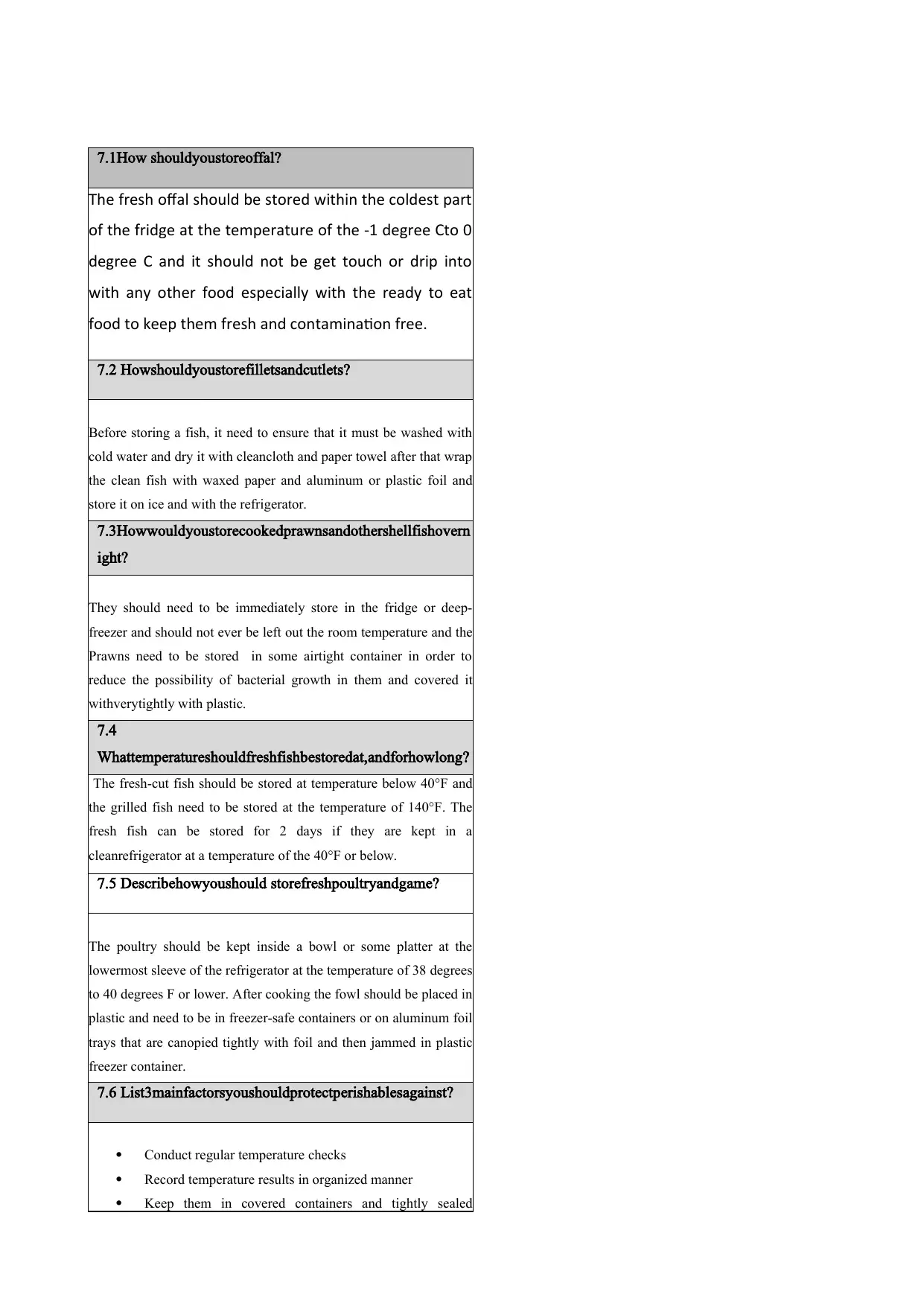
7.1How shouldyoustoreoffal?
The fresh offal should be stored within the coldest part
of the fridge at the temperature of the -1 degree Cto 0
degree C and it should not be get touch or drip into
with any other food especially with the ready to eat
food to keep them fresh and contamination free.
7.2 Howshouldyoustorefilletsandcutlets?
Before storing a fish, it need to ensure that it must be washed with
cold water and dry it with cleancloth and paper towel after that wrap
the clean fish with waxed paper and aluminum or plastic foil and
store it on ice and with the refrigerator.
7.3Howwouldyoustorecookedprawnsandothershellfishovern
ight?
They should need to be immediately store in the fridge or deep-
freezer and should not ever be left out the room temperature and the
Prawns need to be stored in some airtight container in order to
reduce the possibility of bacterial growth in them and covered it
withverytightly with plastic.
7.4
Whattemperatureshouldfreshfishbestoredat,andforhowlong?
The fresh-cut fish should be stored at temperature below 40°F and
the grilled fish need to be stored at the temperature of 140°F. The
fresh fish can be stored for 2 days if they are kept in a
cleanrefrigerator at a temperature of the 40°F or below.
7.5 Describehowyoushould storefreshpoultryandgame?
The poultry should be kept inside a bowl or some platter at the
lowermost sleeve of the refrigerator at the temperature of 38 degrees
to 40 degrees F or lower. After cooking the fowl should be placed in
plastic and need to be in freezer-safe containers or on aluminum foil
trays that are canopied tightly with foil and then jammed in plastic
freezer container.
7.6 List3mainfactorsyoushouldprotectperishablesagainst?
Conduct regular temperature checks
Record temperature results in organized manner
Keep them in covered containers and tightly sealed
The fresh offal should be stored within the coldest part
of the fridge at the temperature of the -1 degree Cto 0
degree C and it should not be get touch or drip into
with any other food especially with the ready to eat
food to keep them fresh and contamination free.
7.2 Howshouldyoustorefilletsandcutlets?
Before storing a fish, it need to ensure that it must be washed with
cold water and dry it with cleancloth and paper towel after that wrap
the clean fish with waxed paper and aluminum or plastic foil and
store it on ice and with the refrigerator.
7.3Howwouldyoustorecookedprawnsandothershellfishovern
ight?
They should need to be immediately store in the fridge or deep-
freezer and should not ever be left out the room temperature and the
Prawns need to be stored in some airtight container in order to
reduce the possibility of bacterial growth in them and covered it
withverytightly with plastic.
7.4
Whattemperatureshouldfreshfishbestoredat,andforhowlong?
The fresh-cut fish should be stored at temperature below 40°F and
the grilled fish need to be stored at the temperature of 140°F. The
fresh fish can be stored for 2 days if they are kept in a
cleanrefrigerator at a temperature of the 40°F or below.
7.5 Describehowyoushould storefreshpoultryandgame?
The poultry should be kept inside a bowl or some platter at the
lowermost sleeve of the refrigerator at the temperature of 38 degrees
to 40 degrees F or lower. After cooking the fowl should be placed in
plastic and need to be in freezer-safe containers or on aluminum foil
trays that are canopied tightly with foil and then jammed in plastic
freezer container.
7.6 List3mainfactorsyoushouldprotectperishablesagainst?
Conduct regular temperature checks
Record temperature results in organized manner
Keep them in covered containers and tightly sealed
Paraphrase This Document
Need a fresh take? Get an instant paraphrase of this document with our AI Paraphraser
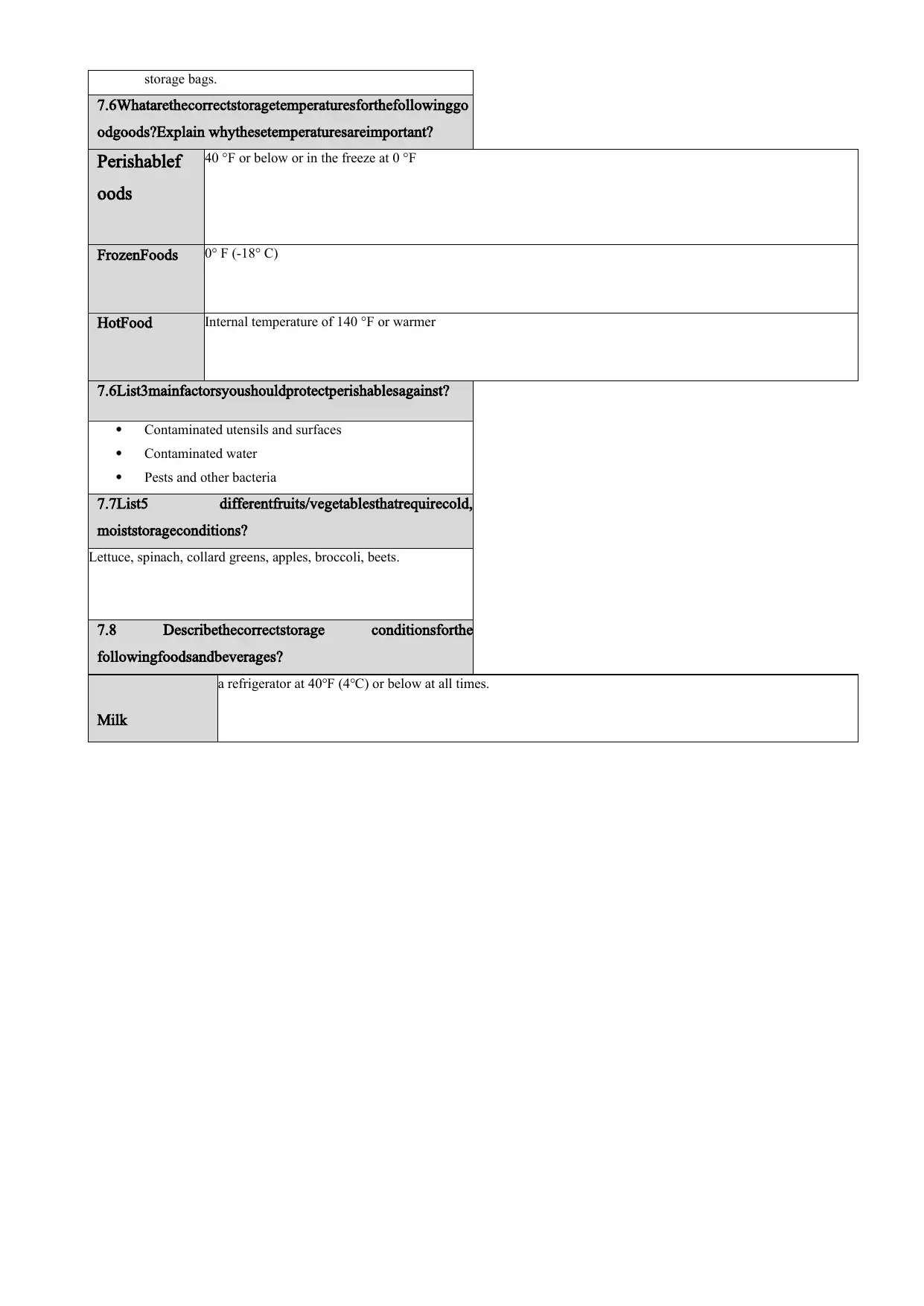
storage bags.
7.6Whatarethecorrectstoragetemperaturesforthefollowinggo
odgoods?Explain whythesetemperaturesareimportant?
Perishablef
oods
40 °F or below or in the freeze at 0 °F
FrozenFoods 0° F (-18° C)
HotFood Internal temperature of 140 °F or warmer
7.6List3mainfactorsyoushouldprotectperishablesagainst?
Contaminated utensils and surfaces
Contaminated water
Pests and other bacteria
7.7List5 differentfruits/vegetablesthatrequirecold,
moiststorageconditions?
Lettuce, spinach, collard greens, apples, broccoli, beets.
7.8 Describethecorrectstorage conditionsforthe
followingfoodsandbeverages?
Milk
a refrigerator at 40℉ (4℃) or below at all times.
7.6Whatarethecorrectstoragetemperaturesforthefollowinggo
odgoods?Explain whythesetemperaturesareimportant?
Perishablef
oods
40 °F or below or in the freeze at 0 °F
FrozenFoods 0° F (-18° C)
HotFood Internal temperature of 140 °F or warmer
7.6List3mainfactorsyoushouldprotectperishablesagainst?
Contaminated utensils and surfaces
Contaminated water
Pests and other bacteria
7.7List5 differentfruits/vegetablesthatrequirecold,
moiststorageconditions?
Lettuce, spinach, collard greens, apples, broccoli, beets.
7.8 Describethecorrectstorage conditionsforthe
followingfoodsandbeverages?
Milk
a refrigerator at 40℉ (4℃) or below at all times.
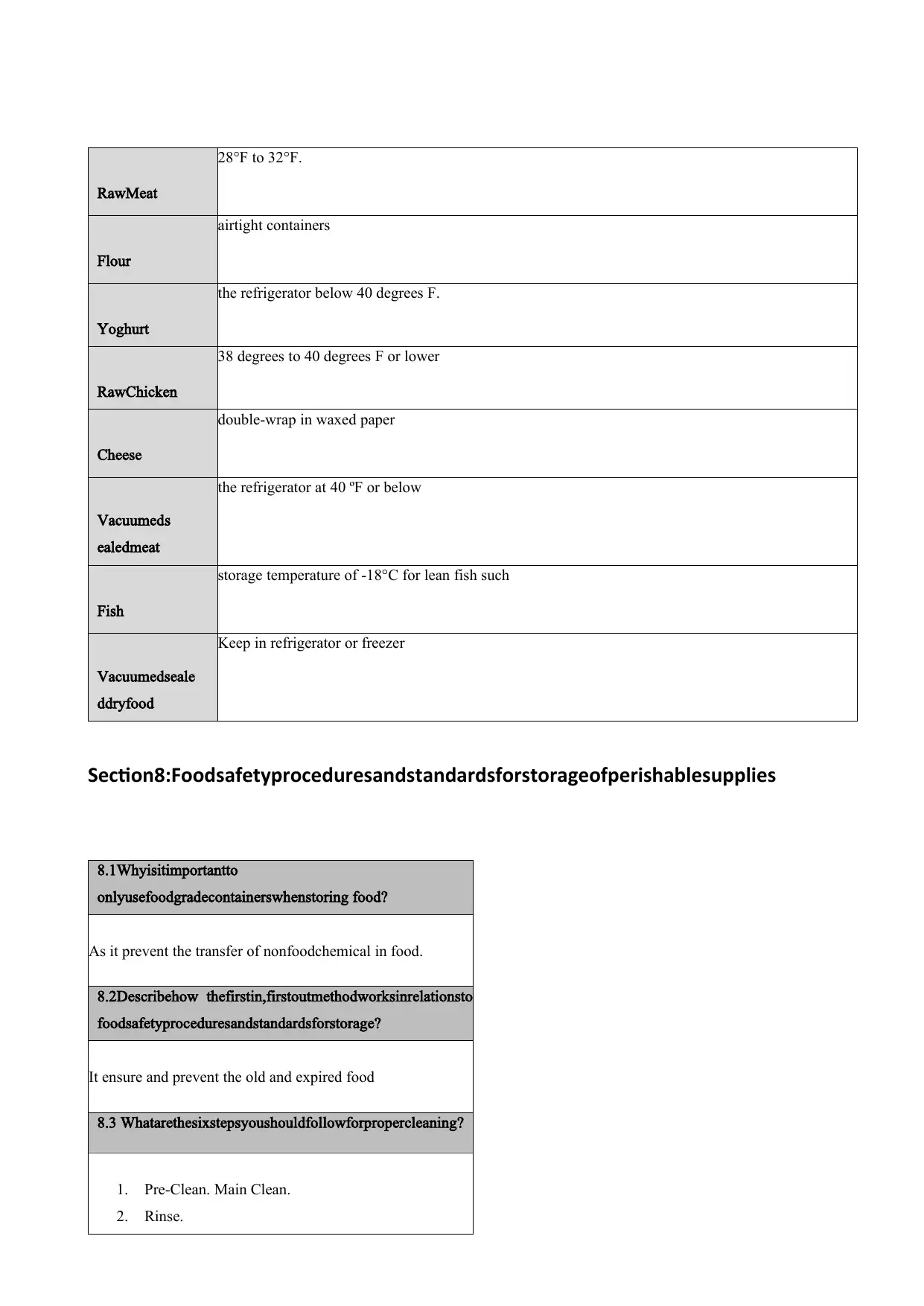
RawMeat
28°F to 32°F.
Flour
airtight containers
Yoghurt
the refrigerator below 40 degrees F.
RawChicken
38 degrees to 40 degrees F or lower
Cheese
double-wrap in waxed paper
Vacuumeds
ealedmeat
the refrigerator at 40 ºF or below
Fish
storage temperature of -18°C for lean fish such
Vacuumedseale
ddryfood
Keep in refrigerator or freezer
Section8:Foodsafetyproceduresandstandardsforstorageofperishablesupplies
8.1Whyisitimportantto
onlyusefoodgradecontainerswhenstoring food?
As it prevent the transfer of nonfoodchemical in food.
8.2Describehow thefirstin,firstoutmethodworksinrelationsto
foodsafetyproceduresandstandardsforstorage?
It ensure and prevent the old and expired food
8.3 Whatarethesixstepsyoushouldfollowforpropercleaning?
1. Pre-Clean. Main Clean.
2. Rinse.
28°F to 32°F.
Flour
airtight containers
Yoghurt
the refrigerator below 40 degrees F.
RawChicken
38 degrees to 40 degrees F or lower
Cheese
double-wrap in waxed paper
Vacuumeds
ealedmeat
the refrigerator at 40 ºF or below
Fish
storage temperature of -18°C for lean fish such
Vacuumedseale
ddryfood
Keep in refrigerator or freezer
Section8:Foodsafetyproceduresandstandardsforstorageofperishablesupplies
8.1Whyisitimportantto
onlyusefoodgradecontainerswhenstoring food?
As it prevent the transfer of nonfoodchemical in food.
8.2Describehow thefirstin,firstoutmethodworksinrelationsto
foodsafetyproceduresandstandardsforstorage?
It ensure and prevent the old and expired food
8.3 Whatarethesixstepsyoushouldfollowforpropercleaning?
1. Pre-Clean. Main Clean.
2. Rinse.
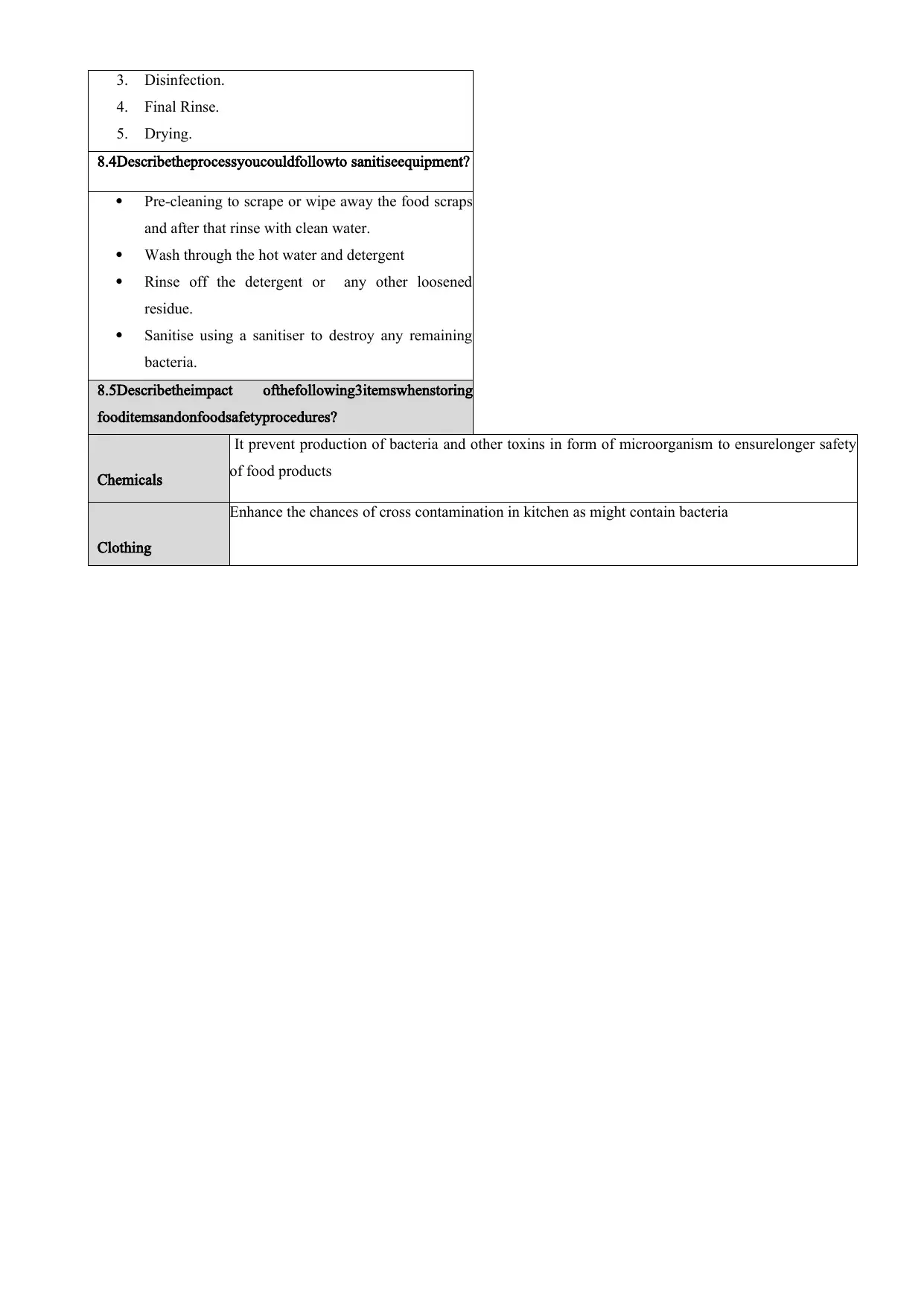
3. Disinfection.
4. Final Rinse.
5. Drying.
8.4Describetheprocessyoucouldfollowto sanitiseequipment?
Pre-cleaning to scrape or wipe away the food scraps
and after that rinse with clean water.
Wash through the hot water and detergent
Rinse off the detergent or any other loosened
residue.
Sanitise using a sanitiser to destroy any remaining
bacteria.
8.5Describetheimpact ofthefollowing3itemswhenstoring
fooditemsandonfoodsafetyprocedures?
Chemicals
It prevent production of bacteria and other toxins in form of microorganism to ensurelonger safety
of food products
Clothing
Enhance the chances of cross contamination in kitchen as might contain bacteria
4. Final Rinse.
5. Drying.
8.4Describetheprocessyoucouldfollowto sanitiseequipment?
Pre-cleaning to scrape or wipe away the food scraps
and after that rinse with clean water.
Wash through the hot water and detergent
Rinse off the detergent or any other loosened
residue.
Sanitise using a sanitiser to destroy any remaining
bacteria.
8.5Describetheimpact ofthefollowing3itemswhenstoring
fooditemsandonfoodsafetyprocedures?
Chemicals
It prevent production of bacteria and other toxins in form of microorganism to ensurelonger safety
of food products
Clothing
Enhance the chances of cross contamination in kitchen as might contain bacteria
Secure Best Marks with AI Grader
Need help grading? Try our AI Grader for instant feedback on your assignments.
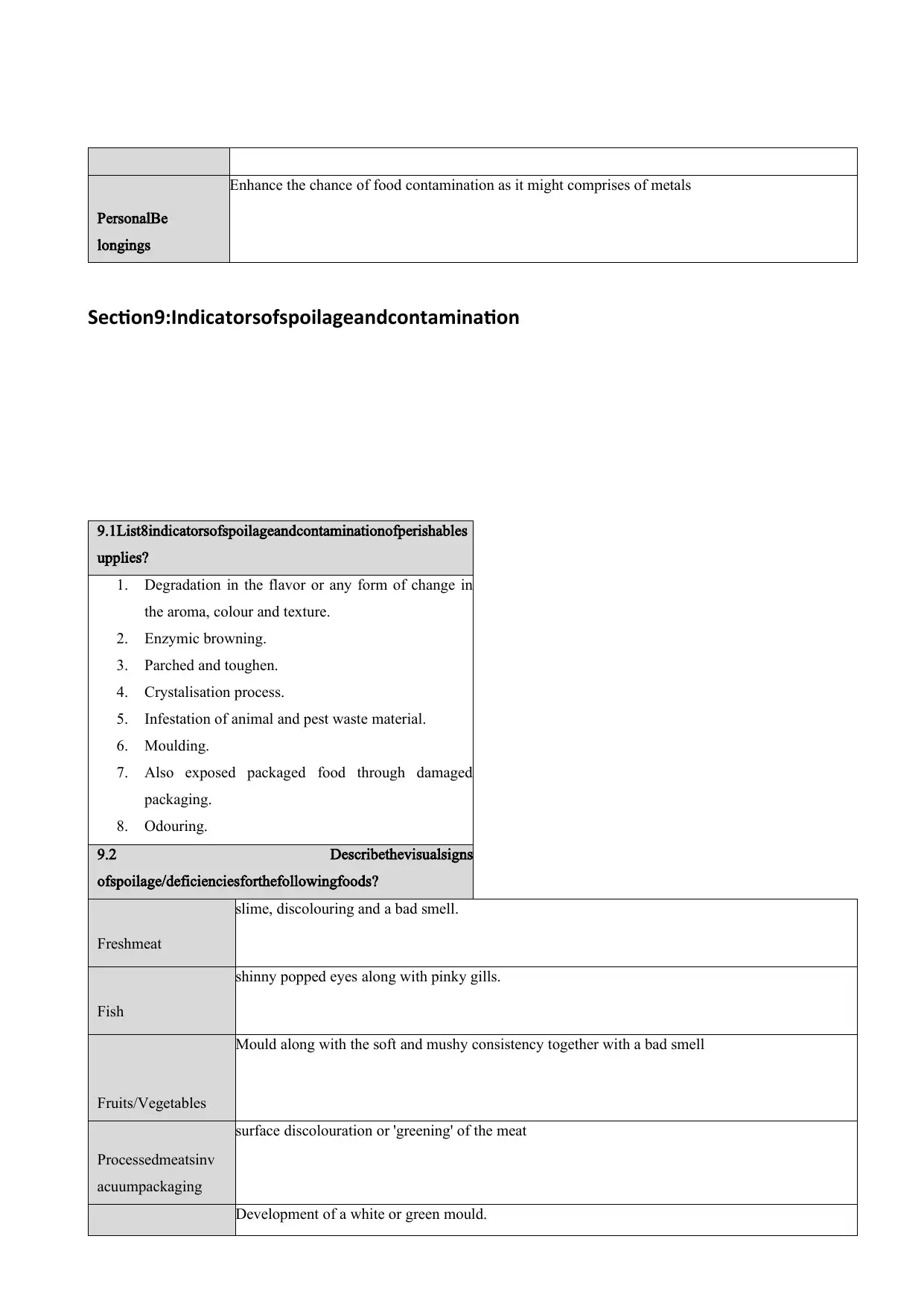
PersonalBe
longings
Enhance the chance of food contamination as it might comprises of metals
Section9:Indicatorsofspoilageandcontamination
9.1List8indicatorsofspoilageandcontaminationofperishables
upplies?
1. Degradation in the flavor or any form of change in
the aroma, colour and texture.
2. Enzymic browning.
3. Parched and toughen.
4. Crystalisation process.
5. Infestation of animal and pest waste material.
6. Moulding.
7. Also exposed packaged food through damaged
packaging.
8. Odouring.
9.2 Describethevisualsigns
ofspoilage/deficienciesforthefollowingfoods?
Freshmeat
slime, discolouring and a bad smell.
Fish
shinny popped eyes along with pinky gills.
Fruits/Vegetables
Mould along with the soft and mushy consistency together with a bad smell
Processedmeatsinv
acuumpackaging
surface discolouration or 'greening' of the meat
Development of a white or green mould.
longings
Enhance the chance of food contamination as it might comprises of metals
Section9:Indicatorsofspoilageandcontamination
9.1List8indicatorsofspoilageandcontaminationofperishables
upplies?
1. Degradation in the flavor or any form of change in
the aroma, colour and texture.
2. Enzymic browning.
3. Parched and toughen.
4. Crystalisation process.
5. Infestation of animal and pest waste material.
6. Moulding.
7. Also exposed packaged food through damaged
packaging.
8. Odouring.
9.2 Describethevisualsigns
ofspoilage/deficienciesforthefollowingfoods?
Freshmeat
slime, discolouring and a bad smell.
Fish
shinny popped eyes along with pinky gills.
Fruits/Vegetables
Mould along with the soft and mushy consistency together with a bad smell
Processedmeatsinv
acuumpackaging
surface discolouration or 'greening' of the meat
Development of a white or green mould.
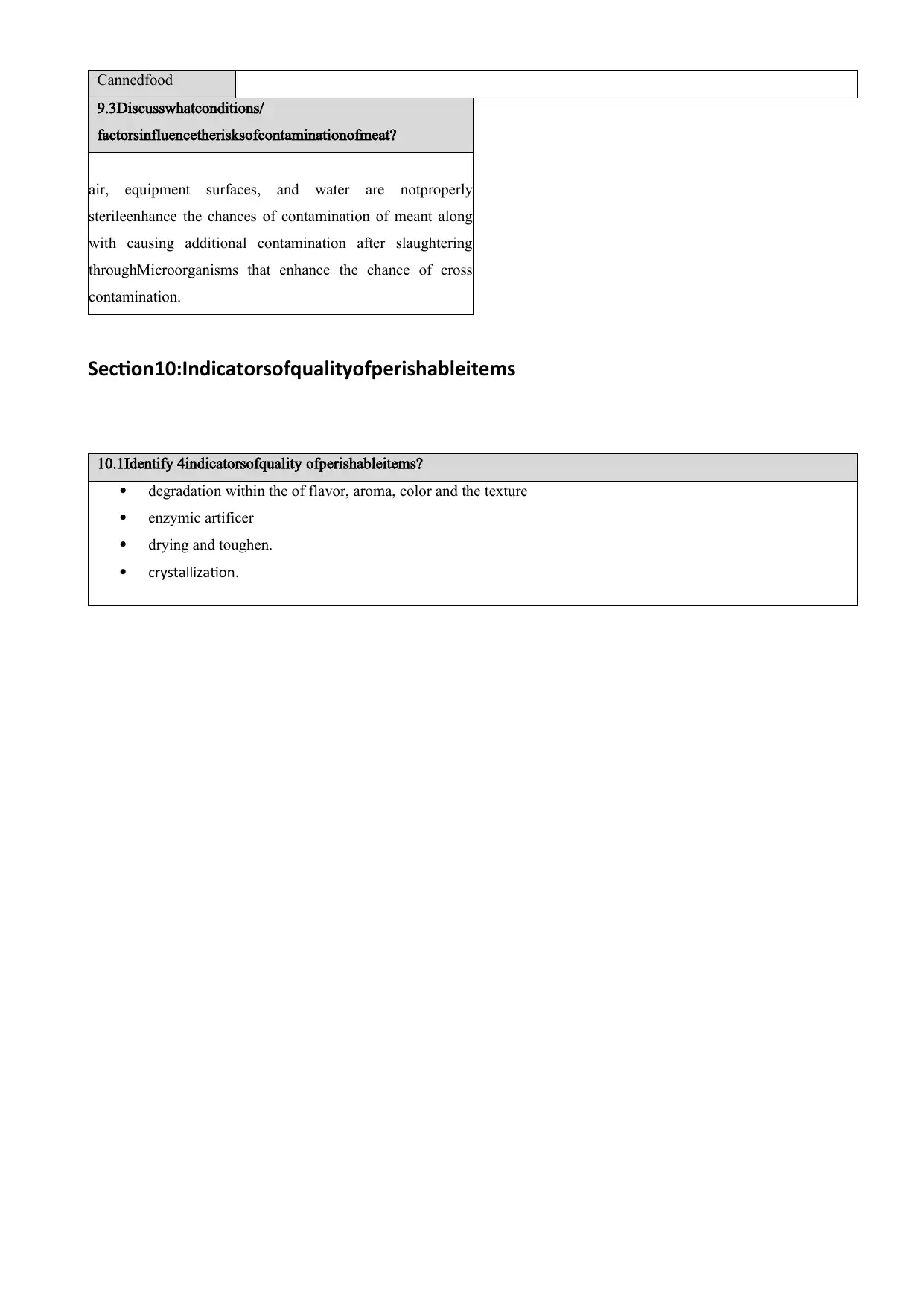
Cannedfood
9.3Discusswhatconditions/
factorsinfluencetherisksofcontaminationofmeat?
air, equipment surfaces, and water are notproperly
sterileenhance the chances of contamination of meant along
with causing additional contamination after slaughtering
throughMicroorganisms that enhance the chance of cross
contamination.
Section10:Indicatorsofqualityofperishableitems
10.1Identify 4indicatorsofquality ofperishableitems?
degradation within the of flavor, aroma, color and the texture
enzymic artificer
drying and toughen.
crystallization.
9.3Discusswhatconditions/
factorsinfluencetherisksofcontaminationofmeat?
air, equipment surfaces, and water are notproperly
sterileenhance the chances of contamination of meant along
with causing additional contamination after slaughtering
throughMicroorganisms that enhance the chance of cross
contamination.
Section10:Indicatorsofqualityofperishableitems
10.1Identify 4indicatorsofquality ofperishableitems?
degradation within the of flavor, aroma, color and the texture
enzymic artificer
drying and toughen.
crystallization.
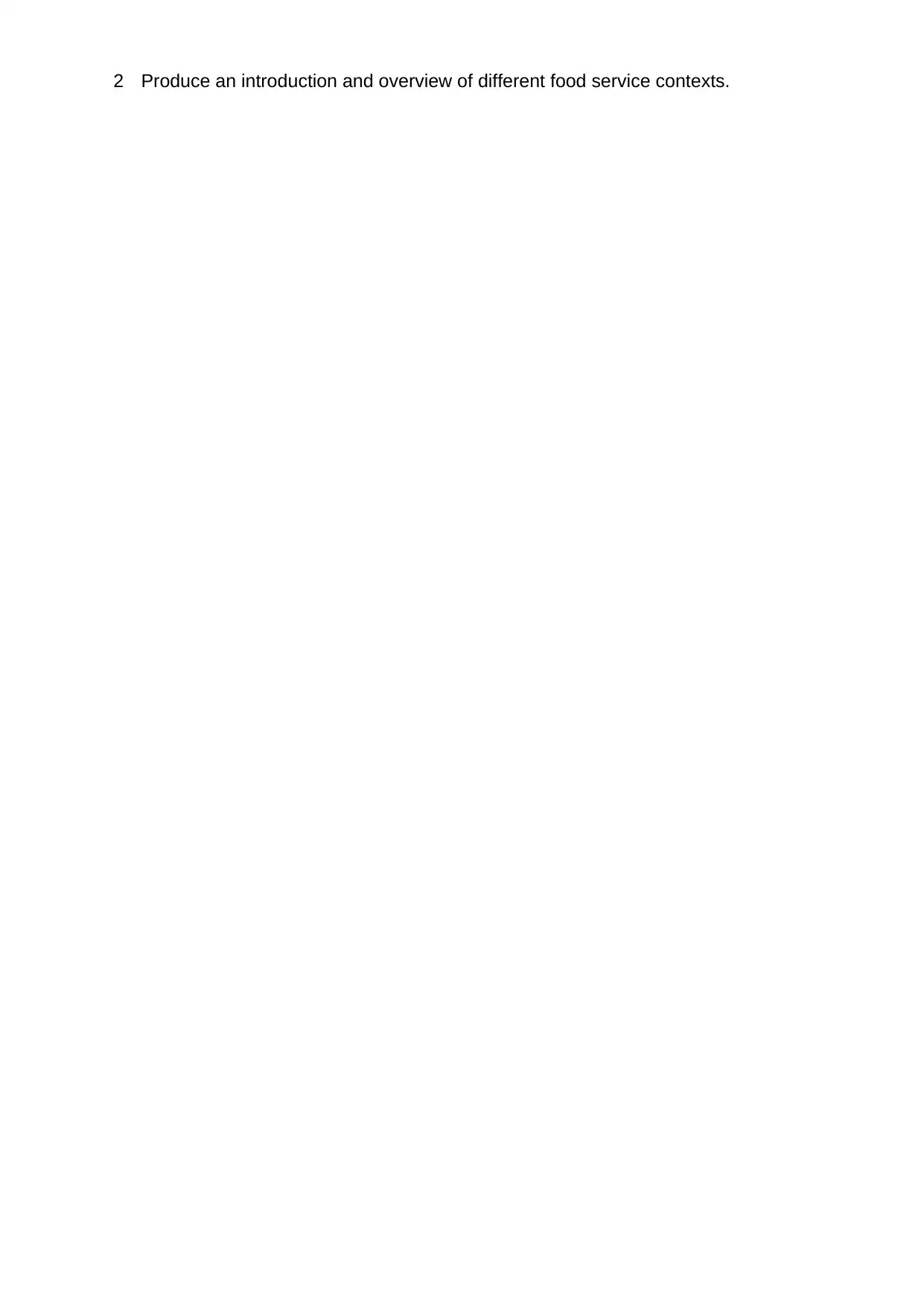
2 Produce an introduction and overview of different food service contexts.
1 out of 37
Your All-in-One AI-Powered Toolkit for Academic Success.
+13062052269
info@desklib.com
Available 24*7 on WhatsApp / Email
![[object Object]](/_next/static/media/star-bottom.7253800d.svg)
Unlock your academic potential
© 2024 | Zucol Services PVT LTD | All rights reserved.